For those of you who aren’t familiar with Inktober (and other month-long creativity challenges), it’s a social-media event where participants draw something related to the official prompt, in ink, each day during the month of October. This is the first time I’ll be participating, so we’ll see how long it takes me to fall off the bandwagon. Of course, I’m going to do a dinosaur spin on each of the prompts. Caveat: I’m not a professional paleoartist, so there may be some inaccuracies (and ugliness) even when I try my best; constructive criticism is much appreciated. Anyway, without further ado, here’s the official list:

And here are my entries so far! I’ll keep updating this with more as the month goes on.
Day 1: Ring
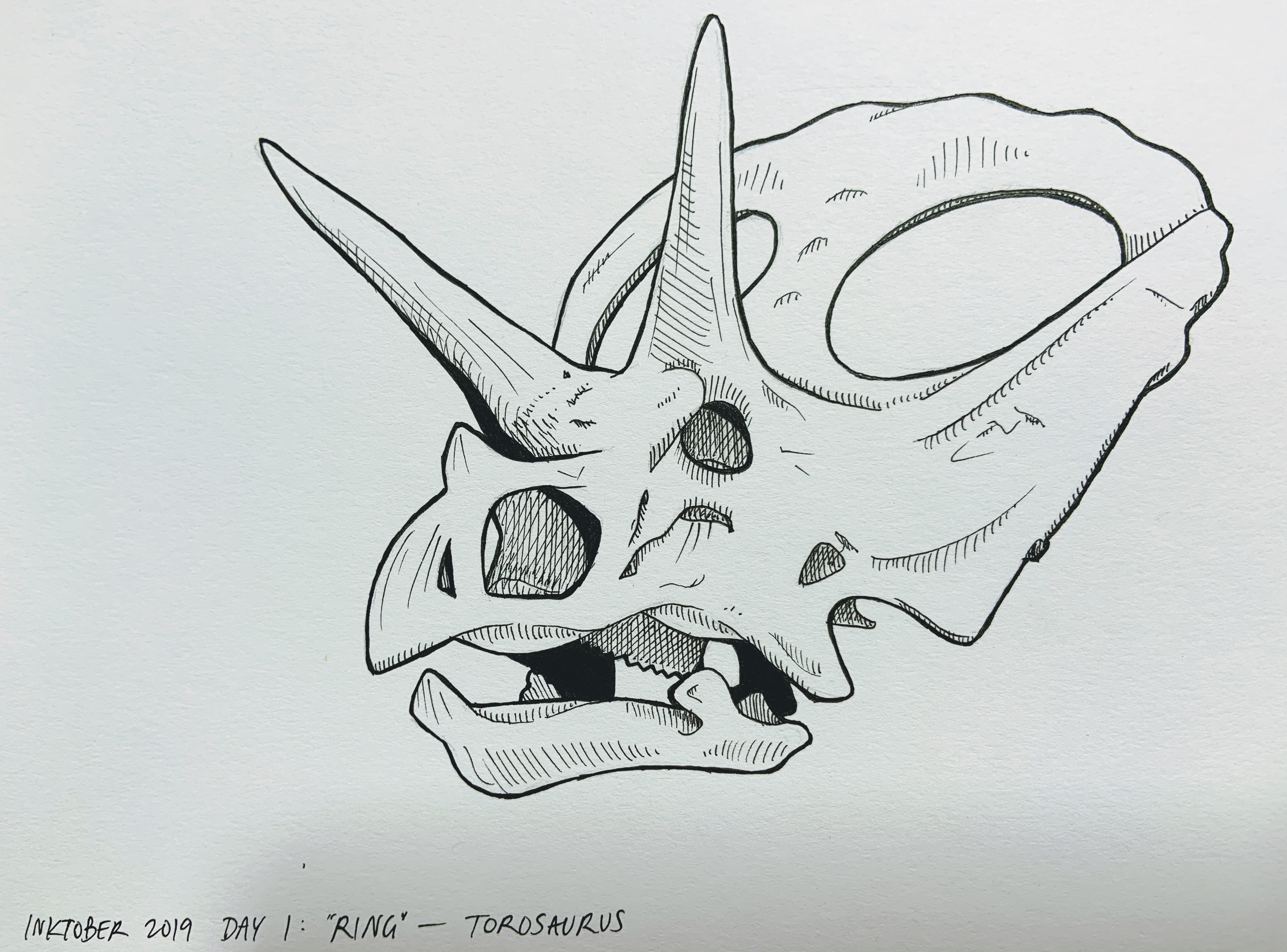
Day 1: Ring - Torosaurus. Drawn in about 40 minutes from photo reference.
Torosaurus (meaning “perforated lizard”) lived in Latest Cretaceous North America, 68-66 million years ago. It lived in the same time and place as Triceratops, to whom it was closely related, but it can be distinguished by its large size, short nose horn, and holey frill. Some paleontologists have suggested that Torosaurus is actually the adult form of Triceratops, but this is not generally accepted. Torosaurus had a record-breaking 9-foot-long skull, the longest of any land animal; in this picture I’m afraid I didn’t do a great job with the foreshortening, so it doesn’t look as huge and impressive as it should.
I picked Torosaurus to be my “ring” because the holes in its frill are so beautifully round. It’s a bit of a stretch, but the only alternative I could think of was the enigmatic Ediacaran fossil Cyclomedusa, and with that I had no idea where to start.
Day 2: Mindless
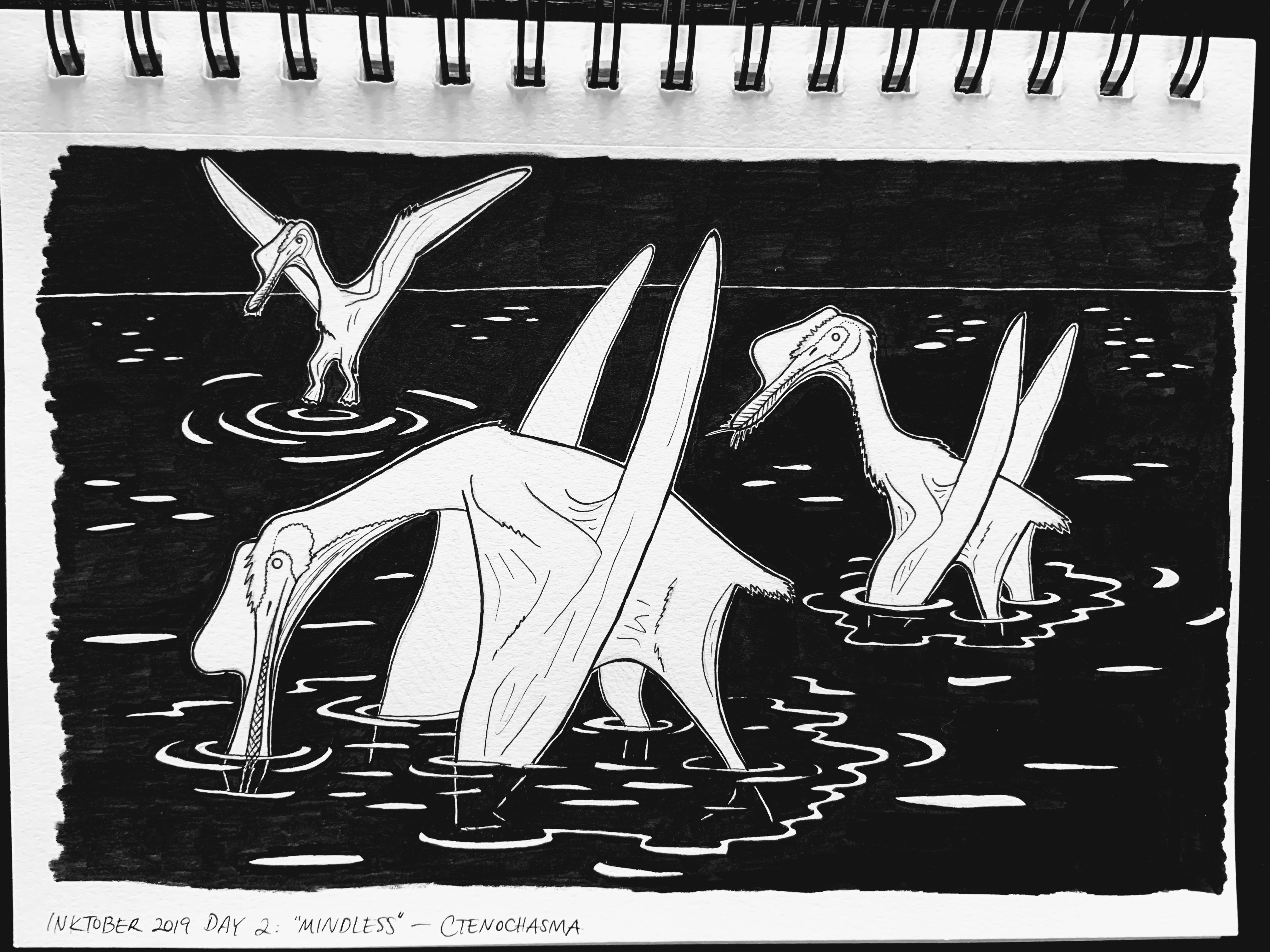
Day 2: Mindless - Ctenochasma. Drawn in about 4 hours. All that black–never again!
Ctenochasma (meaning “comb jaw”) was a Late Jurassic European cat-sized pterosaur with hundreds of skinny, comb-like teeth that it used to strain water for tiny shellfish like a modern spoonbill. Too bad it’s Inktober, or I would’ve colored them flamboyant pink. Here, one Ctenochasma is fishing, one is just chilling, and one is coming in for a landing. Why are they all facing left? Maybe it’s windy and they don’t want to get their pycnofibres ruffled. (The real reason is that being right-handed, I’m much more comfortable drawing animals facing left than right.)
I picked Ctenochasma to be my “mindless” because its inefficient feeding habits probably required it to stand with its face in the water for hours at a time (modern spoonbills do this). I was debating between this and an ornithopod grazer, but I think I have enough opportunities to do ornithopods in other prompts later in the month.
Skeletal reference Integument reference
Day 3: Bait
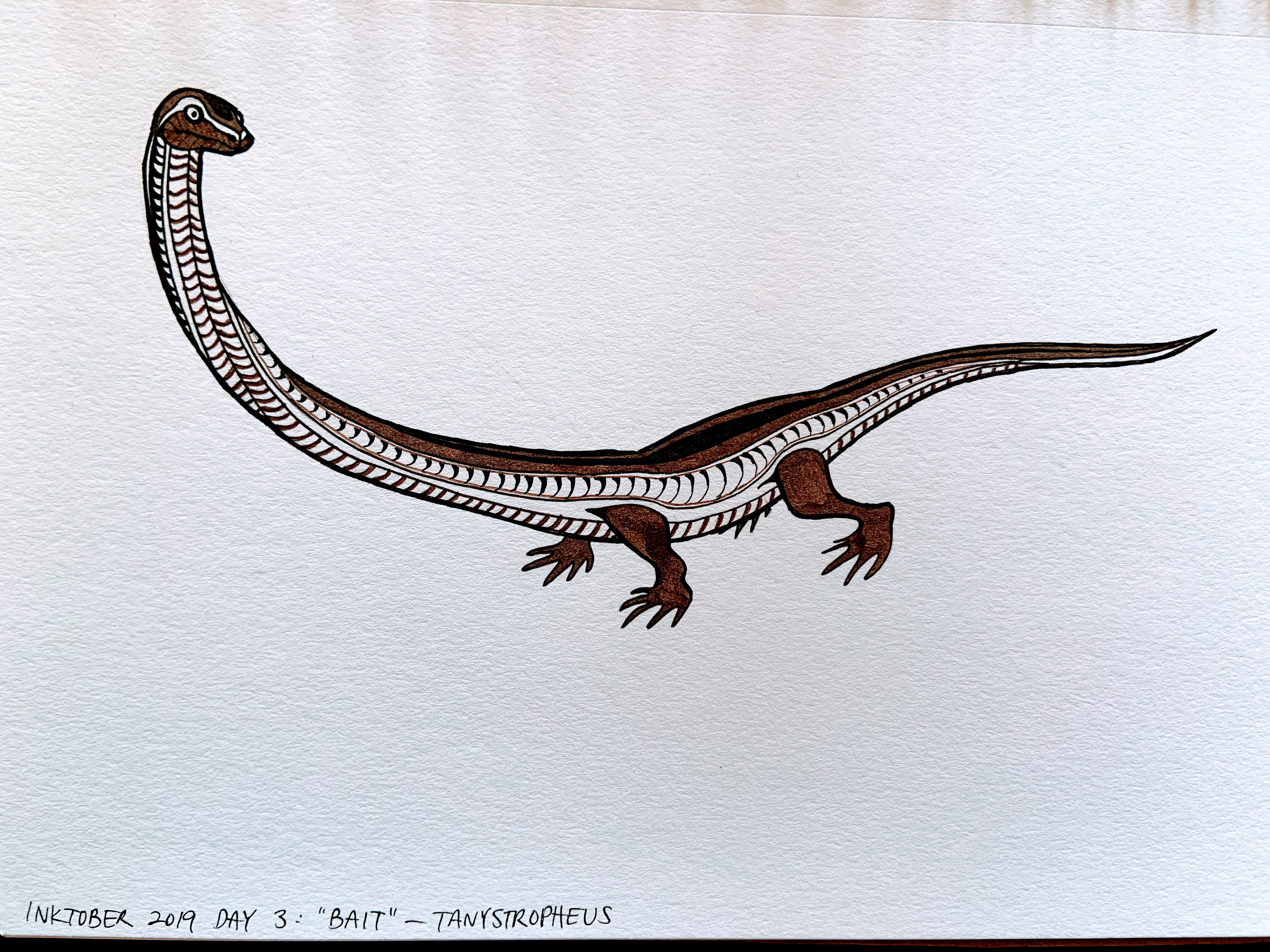
Day 3: Bait - Tanystropheus. Drawn in about an hour. Is using sepia pens cheating?
Tanystropheus (say “TAN-ee-STROW-fee-us”) was a Middle Triassic archosauromorph reptile known as the “living fishing rod”. It was less than 3 feet tall, but 20 feet long, 10 feet of which was neck! The neck was really stiff, made up of only a few super-elongated vertebrae, allowing Tanystropheus to lean its neck out over the water for long periods while it waited for fish and squid to appear–sort of like a heron, but without actually standing in the water. Tanystropheus is well-known from many fossils, including a lot of complete skeletons of juveniles, which show that the juveniles were proportionally just mini-adults. That means their eggs would’ve had to be super long and thin, to fit that stiff neck!
I picked Tanystropheus to be my “bait” because of its claim to fame as the “living fishing rod.” Even though drawing it only took an hour, I spent another hour researching, because I’m not super familiar with weird Triassic reptiles. I wanted to get the proportions, posture, and pose right without just copying someone else’s art. Stylistically, I was going for a sort of ukiyo-e feel, not sure if I succeeded.
Stylistic Inspiration Further reading 1 Further reading 2
Day 4: Freeze
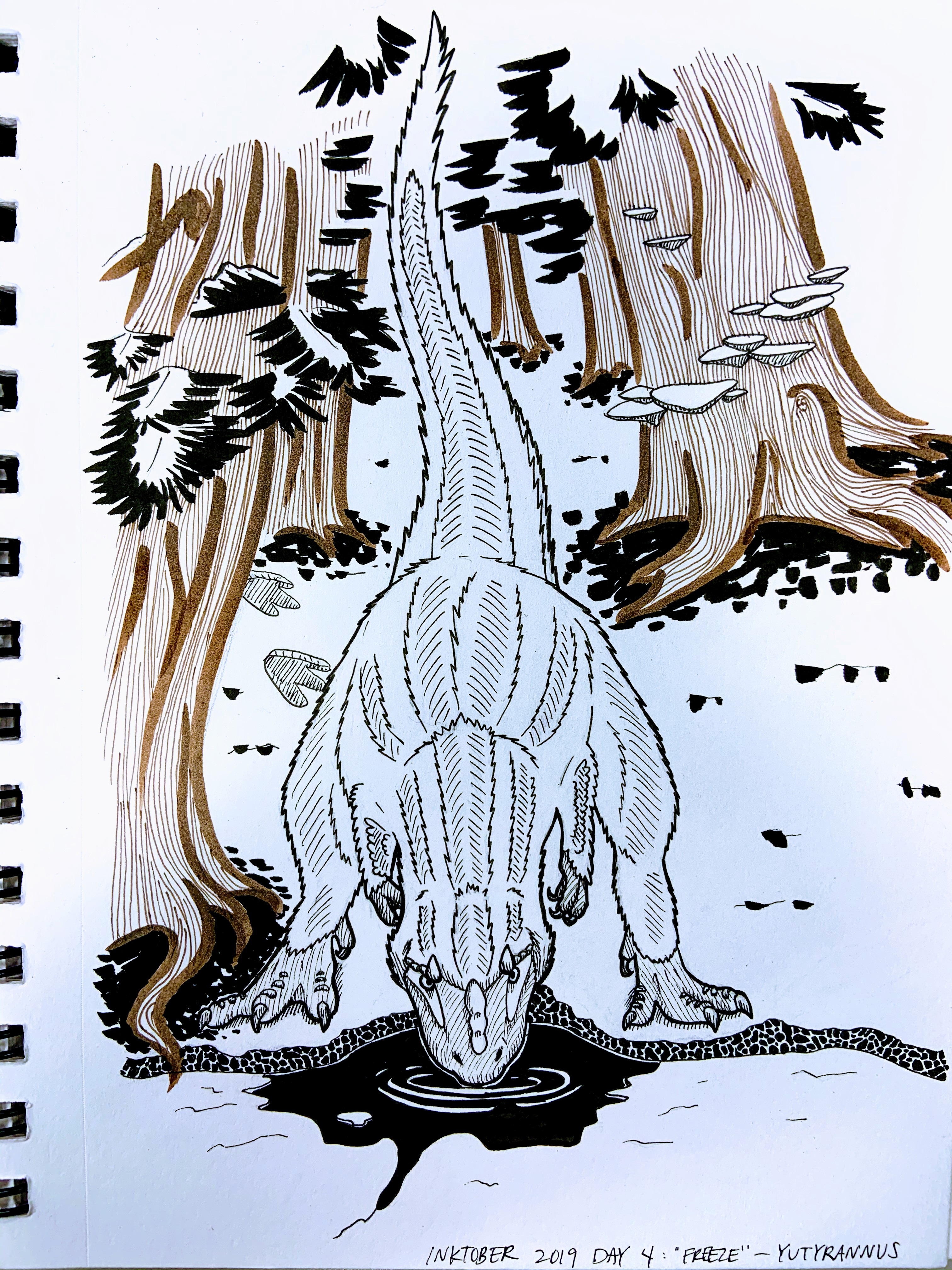
Day 4: Freeze - Yutyrannus. Drawn in about 2 hours.
Yutyrannus (meaning “feather tyrant”) was an Early Cretaceous basal tyrannosauroid from Liaoning (northern China). It’s by far the largest dinosaur we’ve found with preserved feathers, at around 3,000 pounds, and upon its discovery, paleoartists got super excited at the direct evidence that giant carnivorous dinos could be feathered, and started doing things like this:
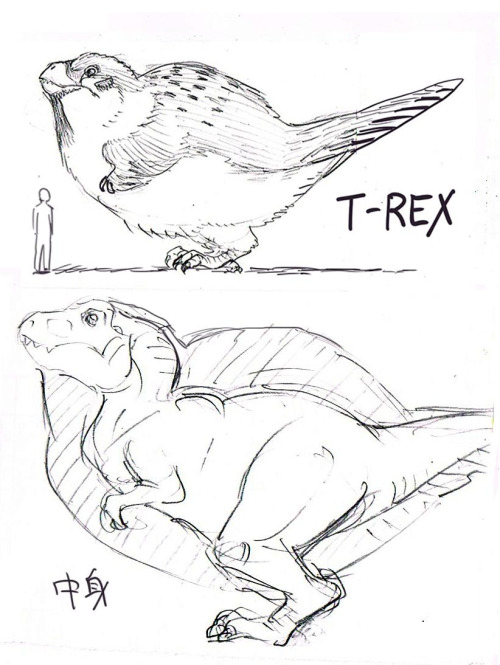
However, Yutyrannus lived in quite different conditions than Tyrannosaurus–the former lived in a temperate climate that would’ve seen snow in the winter, while the latter lived in a subtropical forested floodplain. Plus, Tyrannosaurus is about 13 times heavier, and due to the square-cube law, would’ve had a much harder time dissipating heat. In addition to all this, many tiny, high-res skin impressions from The King have been found that indicate complete scaliness.
I picked Yutyrannus to be my “freeze” because of the seasonal changes it would’ve experienced in its environment. Here, Yutyrannus takes a drink at a frozen pond in early winter, reminiscent of that stereotypical wolf picture. This piece ended up being quite the experiment in textures. Plants are hard.
Day 5: Build

Day 5: Build - Protoceratops. Drawn in about an hour.
Protoceratops was a small ceratopsian from Late Cretaceous Mongolia. It lived in the desert alongside Velociraptor, and was probably cathemeral, meaning that rather than being nocturnal or diurnal, it was active at sporadic times during the day and night.
I chose Protoceratops to be my “build” because of its fossilized record of extensive nesting behavior. A Protoceratops nest and a Psittacosaurus nest (another small basal ceratopsian) have been found that each contained lots of yearlings, which means that the young remained in the nest for quite awhile after hatching. In the case of Psittacosaurus, the nest also contained a subadult that appeared to be babysitting. All this makes me think that Protoceratops probably cared a lot about how its nest was constructed, inspiring this piece.
An interesting thing to note is the large number of dinosaurs in these litters–15 for Protoceratops and 24 for Psittacosaurus. Most animals that care for their offspring only have a few, because of the large amount of resources each one requires. This is known as K-strategy (the K stands for Karrying Kapacity…in German). On the other hand, animals who have a lot of offspring and don’t care for any of them, like a seahorse, are known as r-strategists (the r stands for rate. Both these terms come from the math behind population dynamics). These basal ceratopsians show a confusing mix of both strategies–a rather large number of offspring (though 24 babies is still nothing compared to the thousands put out by many sea creatures) with extensive parental and sibling care.
Day 6: Husky
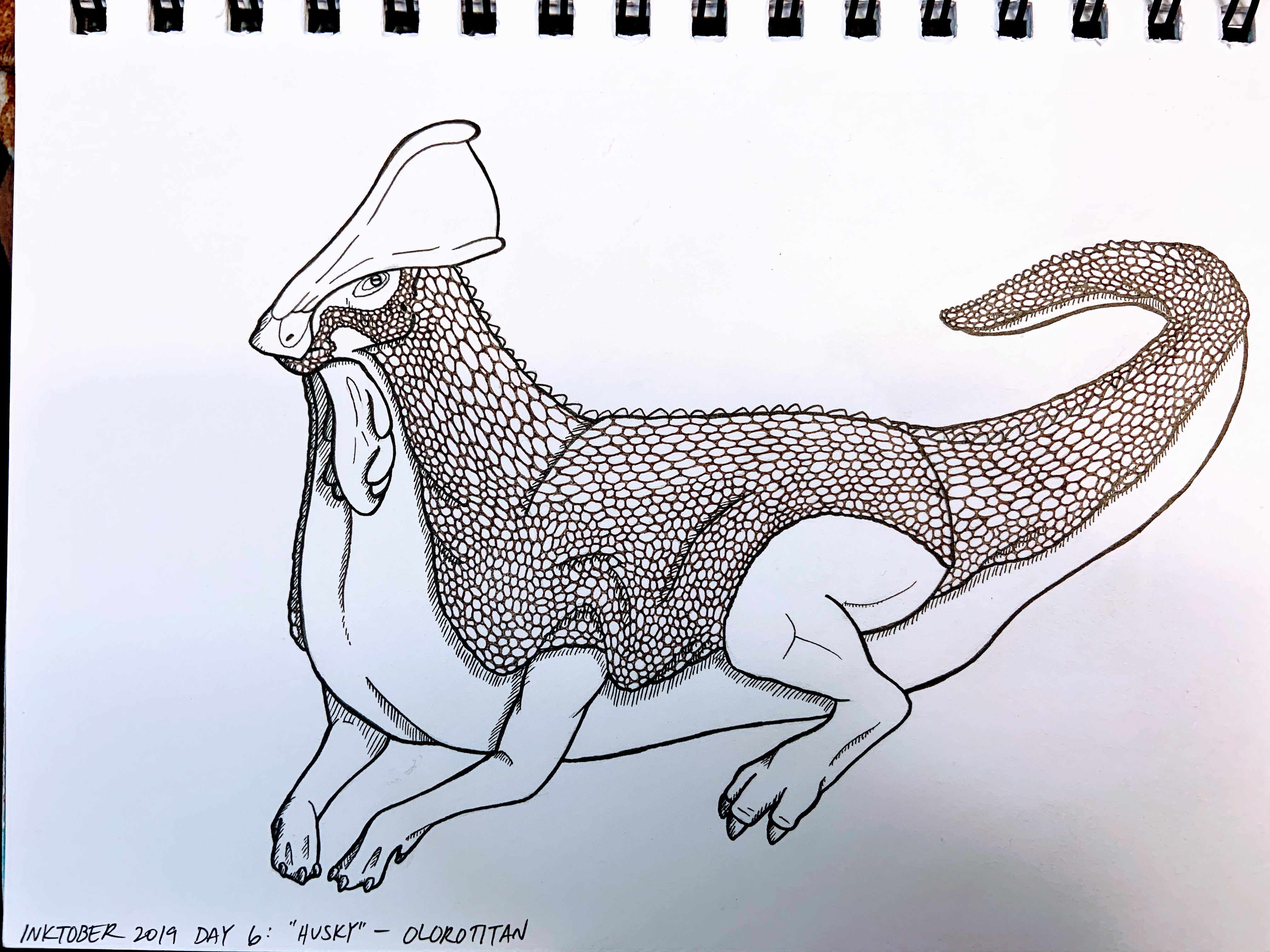
Day 6: Husky - Olorotitan. Drawn in about 4 hours. All those ovals…
Olorotitan (meaning “swan titan”) was a lambeosaurine “duck-billed” dinosaur from Late Cretaceous Russia. Lambeosaurinae are the bony-crested subset of hadrosaurs (the soft- or non-crested group is called Saurolophinae), which were medium-sized grazers with advanced chewing abilities–essentially, they filled the same niche as cows do today. Typically, these guys are pictured as pretty lithe, but in the book All Yesterdays, paleoartist John Conway suggested they may have been a bit more…husky. This illustration is heavily inspired by his depiction of Parasaurolophus from that book.
What’s with the huge, dragonlike scales? A fossil of an Edmontosaurus’s neck and back of head (a related but soft-crested hadrosaur) was found with these huge oval scales preserved. I’ve seen reconstructions that incorporate the big scales on the neck but show the rest of the body with normal-sized scales, but I thought, why would they stop at the neck? And so I got myself into a multi-hour circle-drawing predicament. Here, a bull Olorotitan vegges out. Look how into himself he is.
Day 7: Enchanted
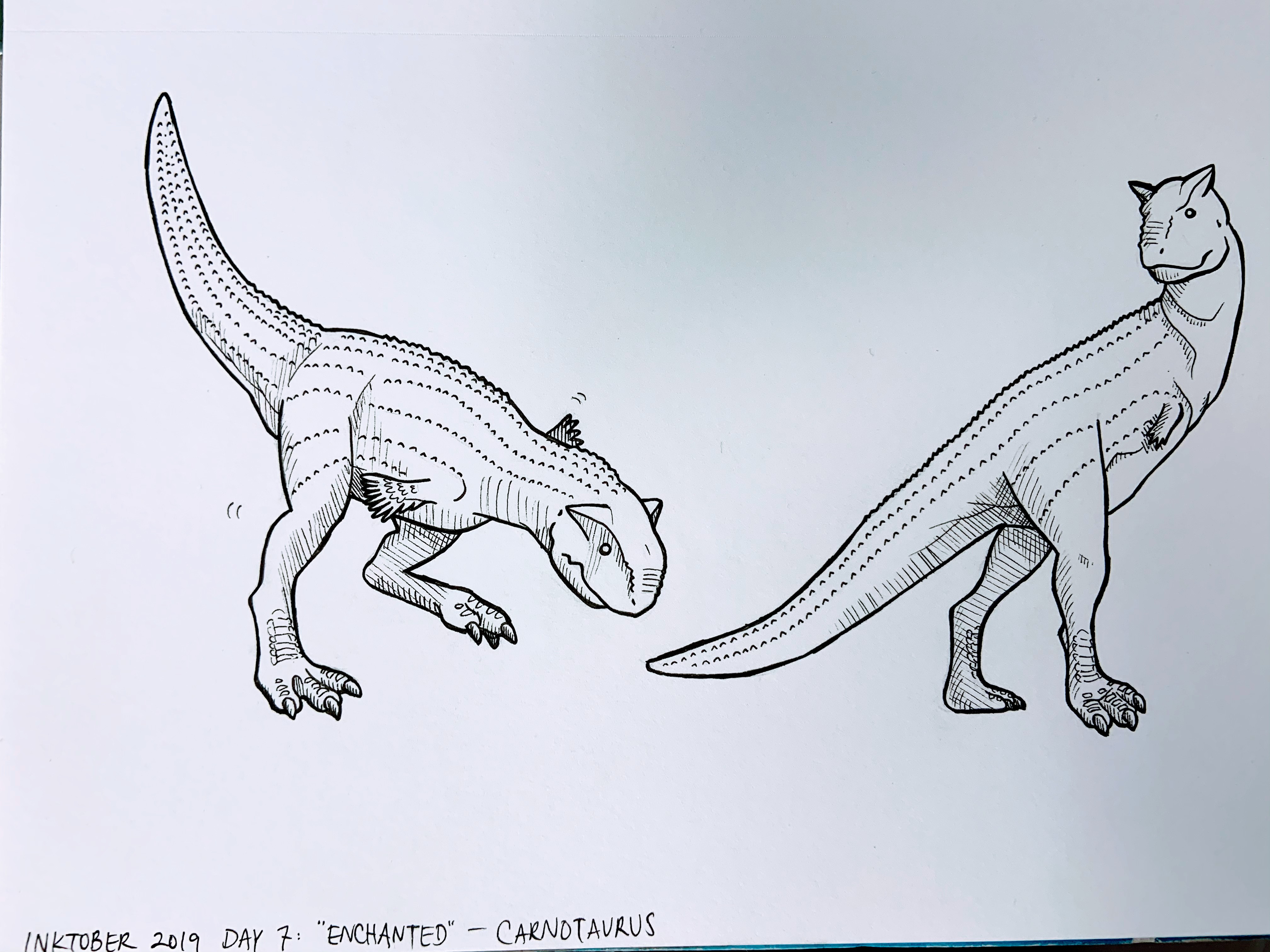
Day 7: Enchanted - Carnotaurus. Drawn in about 40 minutes.
Carnotaurus (meaning “meat bull”–people often say it means “meat-eating bull,” but it doesn’t) was a Late Cretaceous South American abelisaur, a group of short-faced, medium-sized, leggy carnivores with head ornamentation and comically tiny arms. They hunted sort of like big cats, biting once and then holding on until the prey was subdued, rather than going for raw bite force–that’s why their skulls are shorter than, say, Tyrannosaurus: Carnotaurus’s jaws were stronger in torsion but worse in compression. They also weren’t nearly as big; Carnotaurus weighed around 1.35 tonnes, while Tyrannosaurus was about 6 times heavier.
Carnotaurus is known from a single, nearly complete specimen, so while we understand its anatomy well, we don’t know much about its ontogeny or if it exhibited sexual dimorphism. I went with very little sexual dimorphism in this piece because none is apparent in the closely related Majungasaurus, which is known from many specimens. The only difference between Mr. and Ms. in this picture is that the lady has skinnier horns and bare arms, but if they were in color, he would be brightly colored while she would be more plain.
For “enchanted,” I wanted to draw a mating dance, and I picked Carnotaurus because of Trey the Explainer’s video and the “pom pom arms” depiction in All Yesterdays. Their head ornamentation was clearly for display and intra-specific competition (why ram prey if you have a bear trap for a mouth?). Their tiny arms also had an unusually wide range of motion for a theropod, and could stick straight out, possibly making a striking profile when viewed from the front. I based the mating dance pose on that of the sharp-tailed grouse, which seemed ideal for showing off the horns, arms, and tail. Do you think the object of his affection is enchanted, or just humoring him?
Day 8: Frail
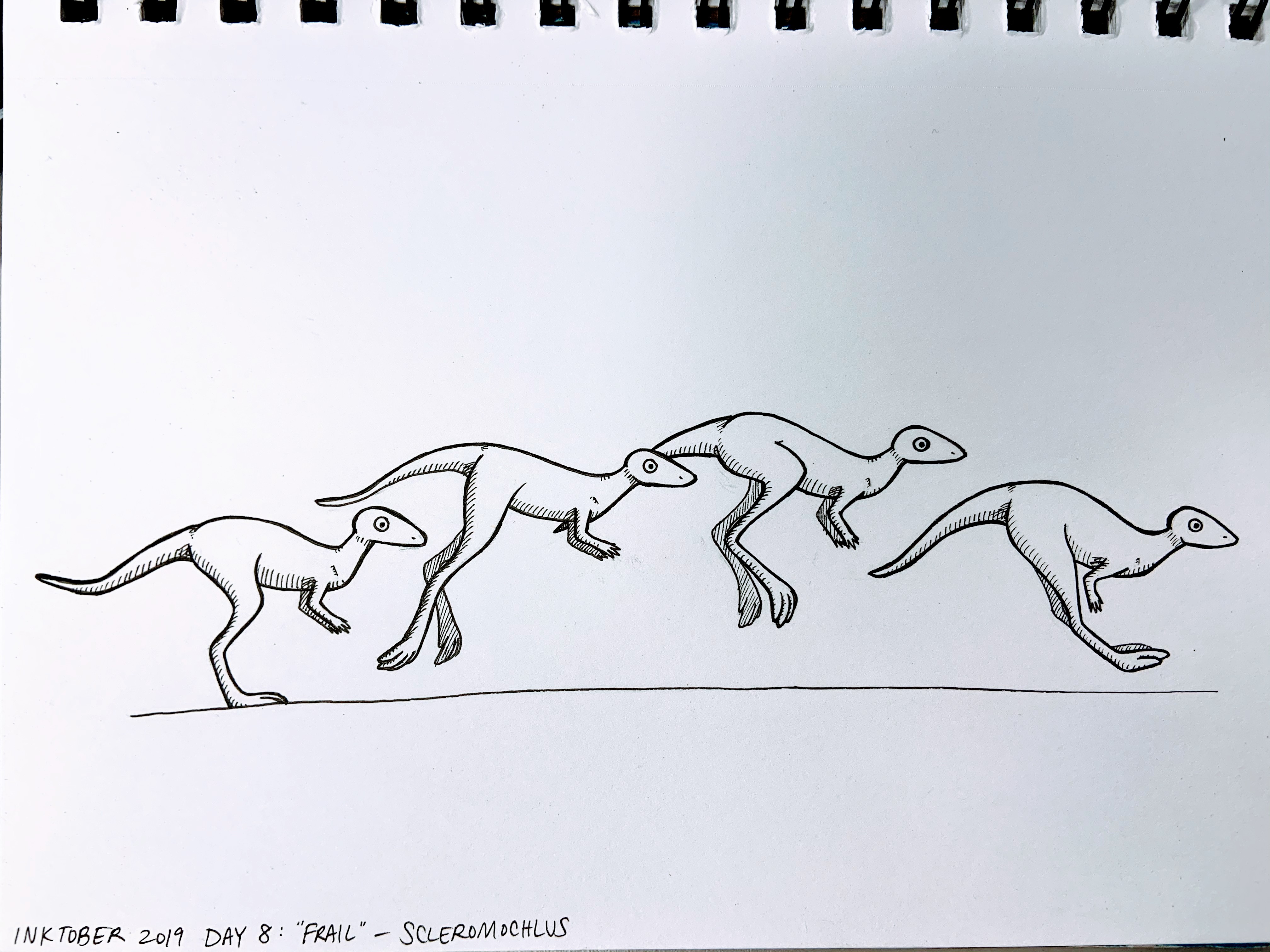
Day 8: Frail - Scleromochlus. Drawn in about 30 minutes. Boing!
Scleromochlus (meaning “hard fulcrum”) was a tiny, desert-dwelling ornithodiran from early Late Triassic Scotland (237-227 million years ago). It is known from several specimens that tend to come in pairs, and is often cited as an ancestral cousin to pterosaurs. Various features of its hips and legs indicate that it was a saltatorial, or hopping, creature, like a kangaroo or jerboa. Hopping seems to be particularly effective in the desert, since it’s evolved multiple times among desert-dwelling creatures.
I picked Scleromochlus to be my “frail” because its long limbs just look like toothpicks, ready to snap at any provocation. I considered doing an early leggy dinosauromorph like Lagerpeton or Ixalerpeton, but those are less well-understood and probably didn’t hop so adorably.
Further reading Hop cycle reference
Day 9: Swing

Day 8: Swing - Megalancosaurus. Drawn in about an hour.
Megalancosaurus was a drepanosaur from Late Triassic Italy, one of a family of oddballs highly convergent with chameleons. They had a clawed tail (the claw was made up of fused vertebrae), two thumbs on their front feet, one or zero thumbs on their back feet (depending on if male or female–how weird is that?) and a pointy head, and were probably insectivorous and arboreal. Some of them, like Hypuronector, may have even glided between trees. Here, a Megalancosaurus swings from its tail to catch an insect. Its humped shoulders provide an attachment site for its strong neck muscles, allowing it to quickly extend its head forward and nab that dragonfly!
Megalancosaurus Skeletal Reference
Day 10: Pattern
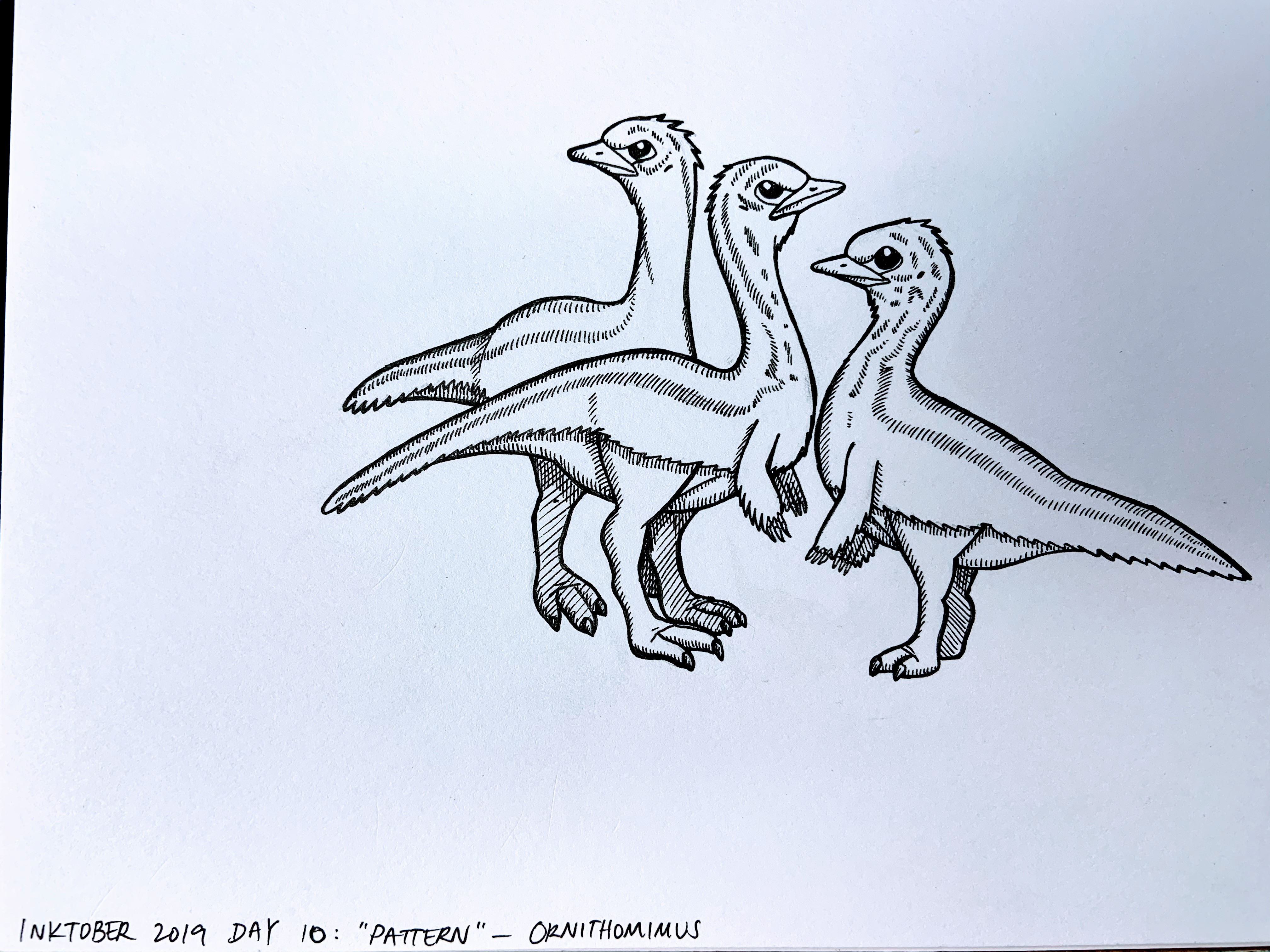
Day 10: Pattern - Ornithomimus (chicks). Drawn in about 40 minutes.
Ornithomimus (meaning “bird mimic”) was an ornithomimid dinosaur from Late Cretaceous North America. They were extremely convergent with ratites (the family of flightless birds that includes ostriches), but given ornithomimids did it first, it would be more accurate to say that ratites are ornithomimid mimics. Ornithomimus had a long neck, long legs, and a little head with a toothless beak. A specimen found in 2015 with feathers and skin preserved indicates that their integument was also very convergent with ratites, not just their skeletal structure. We know that Ornithomimus had feathers basically everywhere except its legs, which it probably used for thermoregulation (maybe it even peed on its legs like a vulture to keep cool?), and that adults had pennaceous feathers on their arms while juveniles did not, indicating that these feathers were for sexual display.
I picked Ornithomimus to be my “pattern” because baby ostriches have adorable stripes, so it’s not a bad guess to say baby Ornithomimus did too. Many animals start out life stripy or spotty and then lose the patterning later on when they develop other defenses besides camouflage.
Photo Reference Ornithomimus Integument
Day 11: Snow

Day 11: Snow - Leaellynasaura. Drawn in about an hour.
Leaellynasaura was a small ornithischian from Early Cretaceous Australia, at a time when Australia was joined to Antarctica and South America and all three had areas within the Antarctic Circle. The climate was much milder than today’s Antarctica, but the animals that lived there would have still had to deal with months-long darkness and frigid conditions.
Leaellynasaura is often drawn with a thin layer of protofeathers, which it is likely it would have needed to survive the harsh winters. However, here I dressed up my Leaellynasaura like a snowy owl, with a thick layer of more complex feathers that go all the way down to the feet to create a wide snowshoe for walking on powder without sinking. The arms are totally hidden in fluff, and only the face is bare. This depiction has at least a little basis in fact, since we now know that ornithischians did sometimes have complex feathers, a la Kulindadromeus.
Leaellynasaura had one of the longest tail-to-body ratios of any animal. What was it used for? Some suggest they were held upright like a signpost so that they could find each other and stay together. Others suggest it was a false head, used to try to get a predator to focus on the wrong end.
Day 12: Dragon
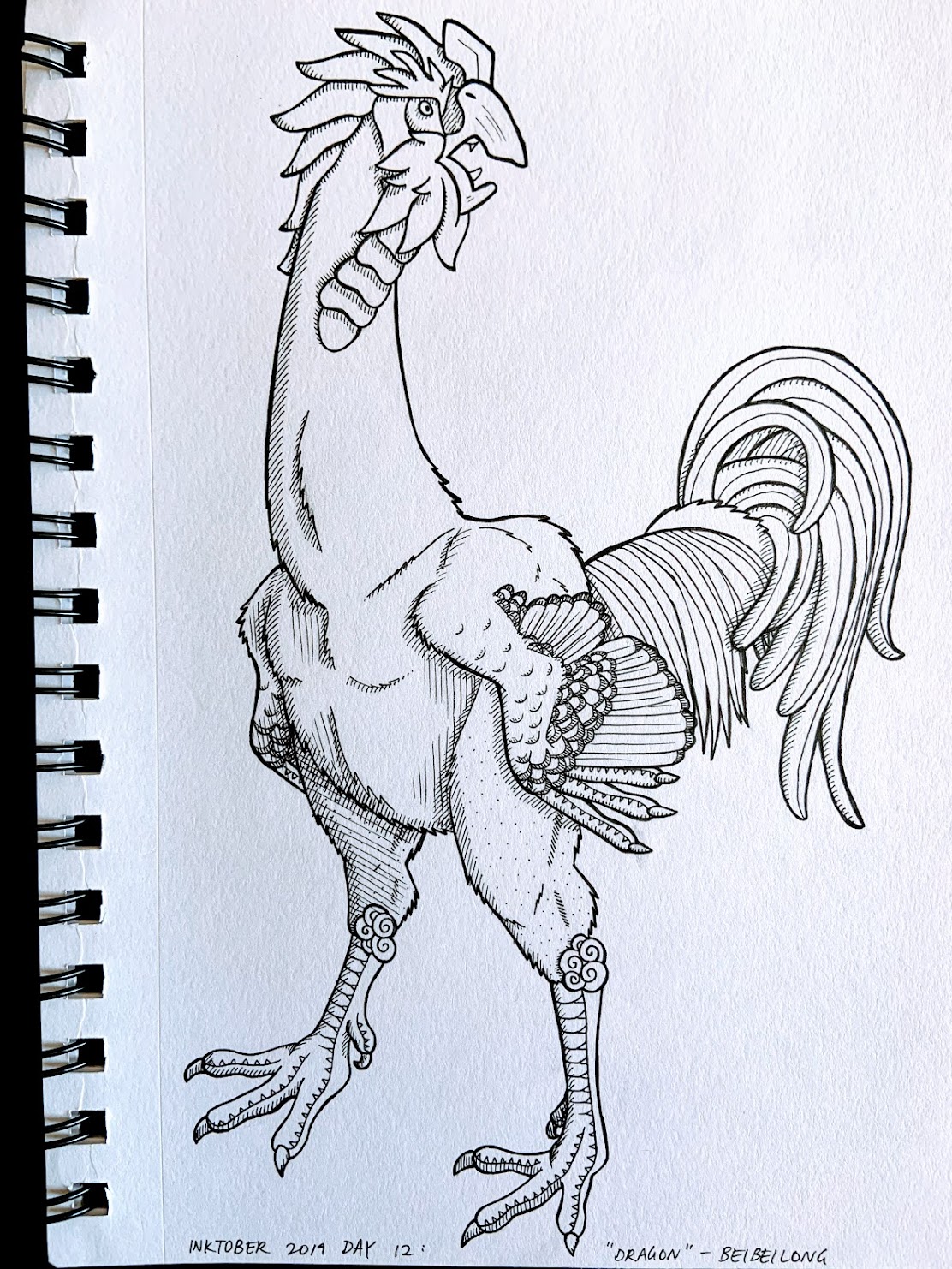
Day 12: Dragon - Beibeilong. Drawn in about 3 hours.
Beibeilong (meaning “baby dragon”) was a giant oviraptorosaur from early Late Cretaceous China. It is known from a single fossilized embryo inside a two-foot-long egg named “Baby Louie,” which was discovered back in 1993 but only described as a new genus in 2017. Part of the holdup was that the fossil had been expatriated to the United States. The other part was that Beibeilong’s closest relative, Gigantoraptor, wasn’t discovered until 2007. Before that, scientists didn’t think oviraptors could get big enough to lay such a huge egg.
I based my Beibeilong’s plumage off that of a rooster, since oviraptorosaurs look a lot like oversized fowl. I tried to evoke an ukiyo-e style dragon kind of feel using its combs and wattles.
Stylistic Reference Gigantoraptor Reference
Day 13: Ash
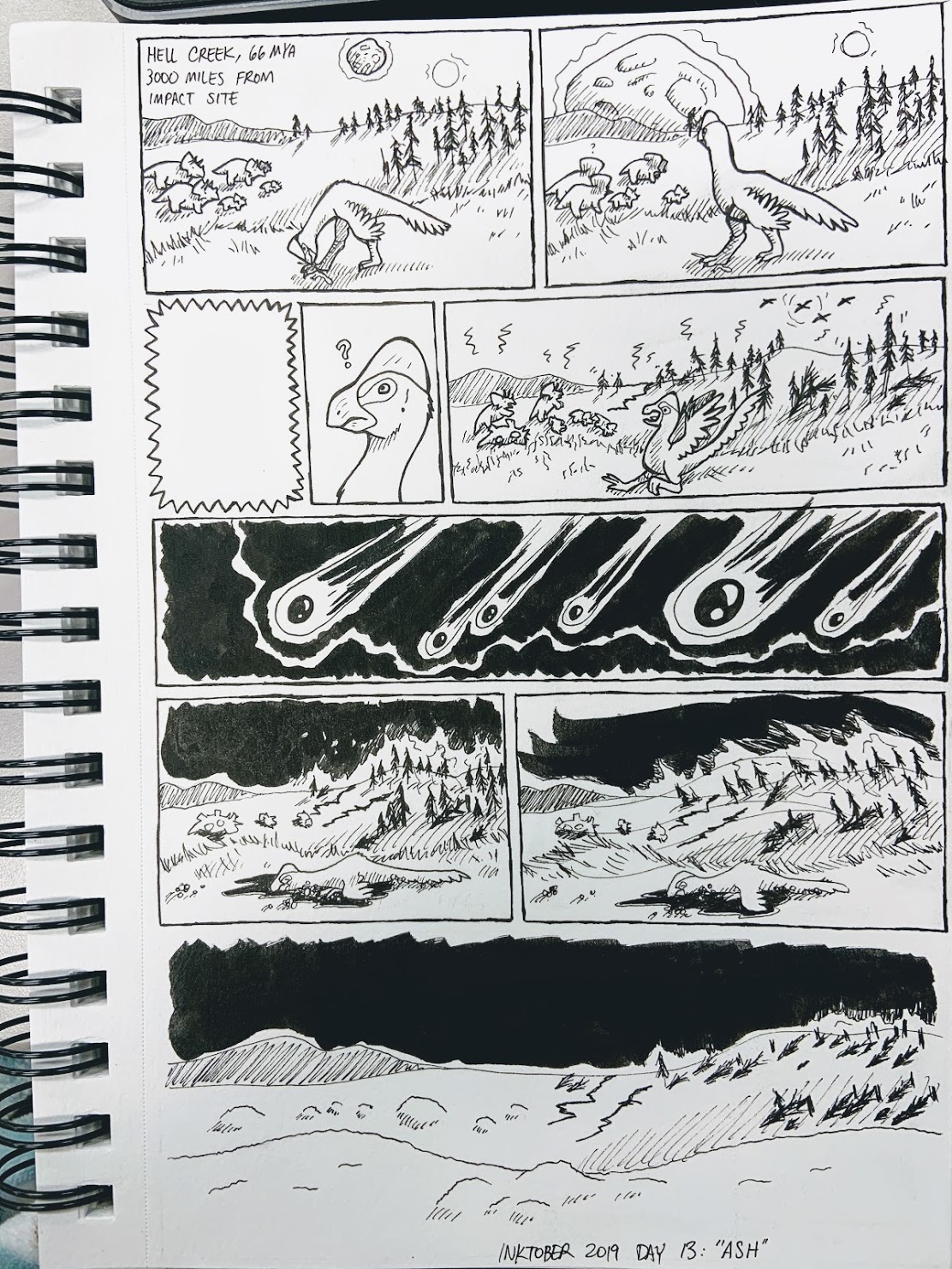
Day 13: Ash - The Very Bad Day. The final day of the Cretaceous period. Drawn in about 2 hours. Featured animals: Triceratops and Anzu.
- For the past few days, the dinosaurs would’ve seen the asteroid rising and setting like the sun, getting steadily bigger in the sky.
- A blinding flash
- Earthquakes! Even the biggest dinosaurs are thrown into the air. Many of them die from this.
- Tektites (pea-sized chunks of hot glass) rain down, burning and choking animals directly but also heating the air and causing numerous forest fires.
- Tornado-force winds sweep the area, expanding the fires, knocking down trees, and causing floods.
- Ash. Volcanic ash and soot from the forest fires blocks the sky for a long time, causing plants to die from acid rain and lack of sunlight. This makes the whole food web collapse.
This comic is largely based on Steve Brusatte’s description from his book The Rise and Fall of the Dinosaurs: A New History of a Lost World, which is an excellent book I highly recommend, to both beginners and seasoned paleo fans.
Day 14: Overgrown
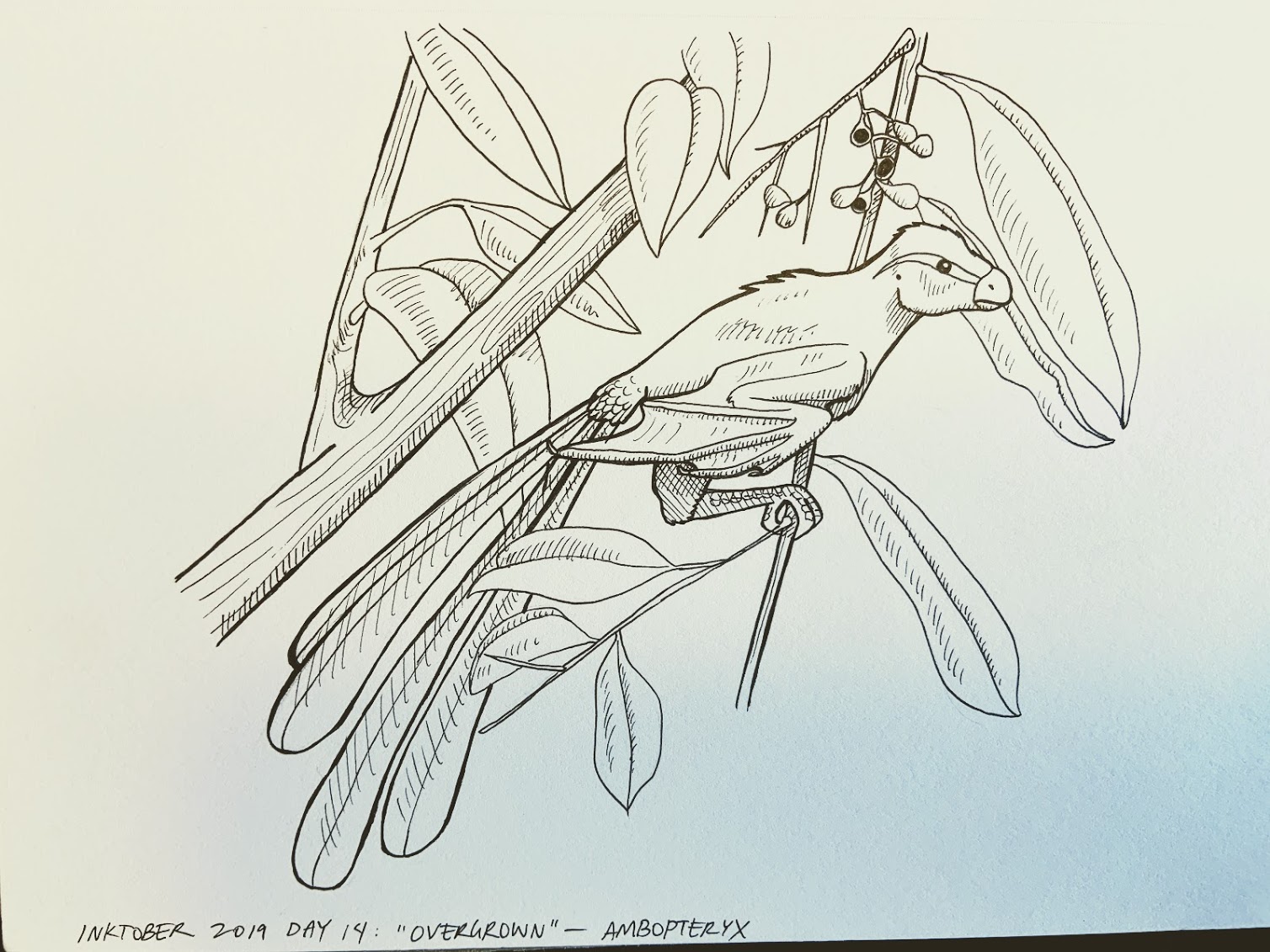
Day 14: Overgrown - Ambopteryx. Drawn in about 40 minutes.
Ambopteryx (meaning “both wing”) was a scansoriopterygid from Late Jurassic China. It was one of a group of very strange “bat-winged” dinosaurs that glided using a skin membrane stretched between their body and elongated third finger. They also had feathers (hence the name). This is one of at least four times that different branches of theropods developed wings independently, and definitely the strangest.
Ambopteryx was just described in May of this year, and is the second scansoriopterygid found preserved with membranes intact (the first was Yi, 2015). The Ambopteryx holotype also preserves the long individual tail feathers. Before Yi, we had no idea how these bat-winged dinos lived-—many thought they poked their elongated finger into trees like an aye aye.
I picked Ambopteryx to be my “overgrown” because it probably lived in the deep forest and hid amongst the vegetation…a bit of a stretch I guess. I don’t know much about plants so please forgive me if the plants shown here are totally anachronistic.
Day 15: Legend
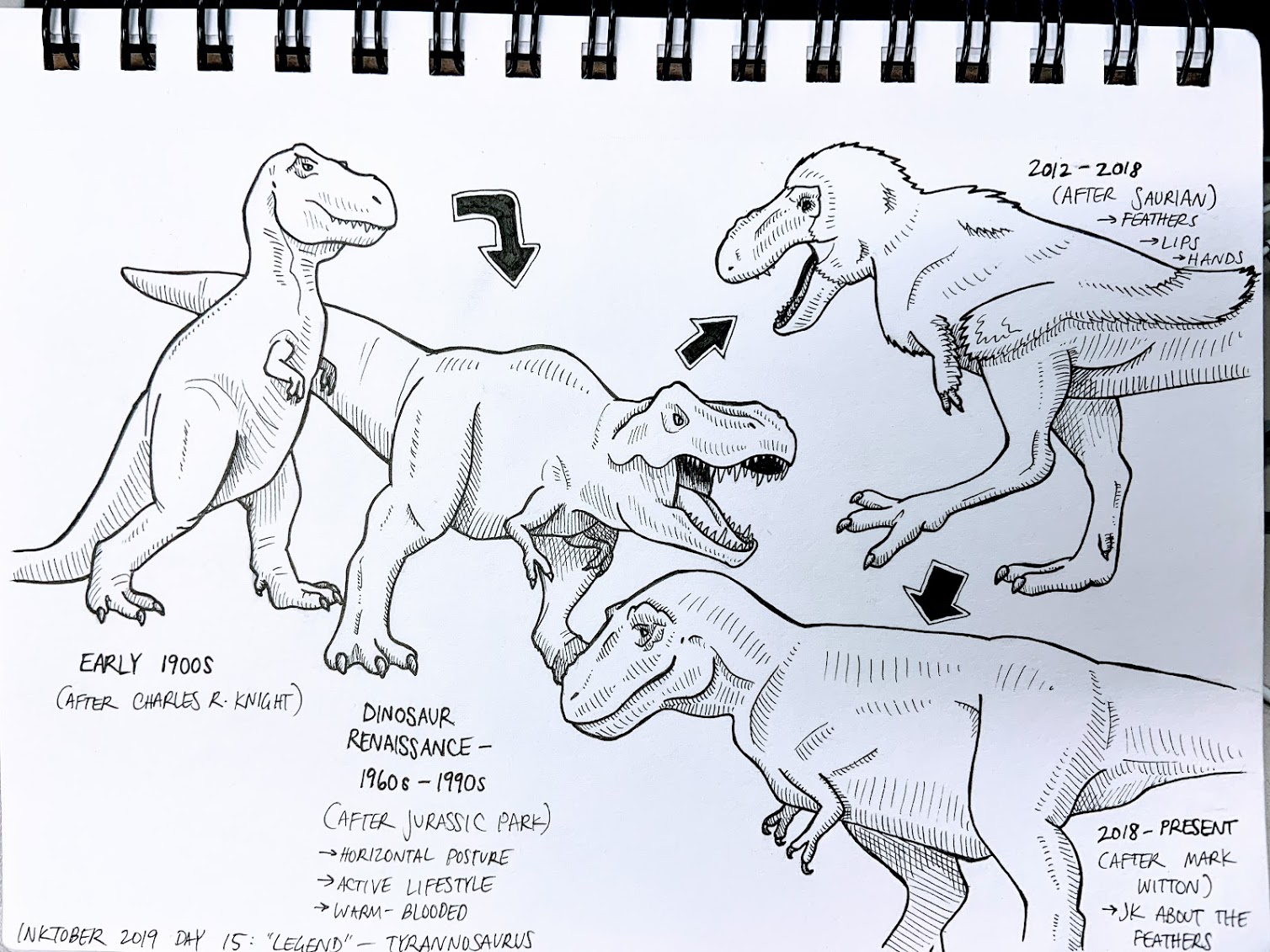
Day 15: Legend - Tyrannosaurus rex through the years.
Here are four depictions of Tyrannosaurus showing how our understanding of this legendary dinosaur has changed over the years.
- In the early 1900s, dinosaurs and paleontology were very much in vogue. Charles R. Knight was one of the most influential paleoartists of the time, capturing the public imagination with dynamic scenes featuring extinct creatures. Paleontology and paleoart were very young back then, and though we can now spot a lot of inaccuracies, the scientists and artists of the time did a really good job with what they knew then.
- In the Dinosaur Renaissance beginning in the late 1960s with the discovery of Deinonychus and culminating in the release of the movie Jurassic Park in 1993, dinosaurs re-emerged into the public view with new vitality. Now their relationship to birds was well accepted, and they were understood to be warm-blooded, active, successful animals rather than sluggish, oversized swamp lizards that deserved to go extinct. Theropods’ posture was corrected–they stopped being shown dragging their tails and walking upright like kangaroos, and instead were depicted balancing horizontally with stiffened tails.
- In 2012, the discovery of Yutyrannus, a completely feathered yeti-esque tyrannosaur, caused paleoartists to start feathering basically all coelurosaurs, including The King, due to the principle of phylogenetic bracketing. The hyper-realistic dinosaur simulator game Saurian was no exception, creating a beautiful fluffy rex (though they’ve since updated their depiction again to reflect more current findings). Some other important corrections between this depiction and the Dinosaur Renaissance one are the presence of lips that cover the teeth while the mouth is closed and hands that are oriented as if about to clap rather than pronated like a cat’s paws.
- Since 2012, more discoveries of Tyrannosaurus skin impressions show that it was probably entirely secondarily scaly, having lost its feathers as it got super-sized in order to better cool off. Read more about this here.
Day 16: Wild
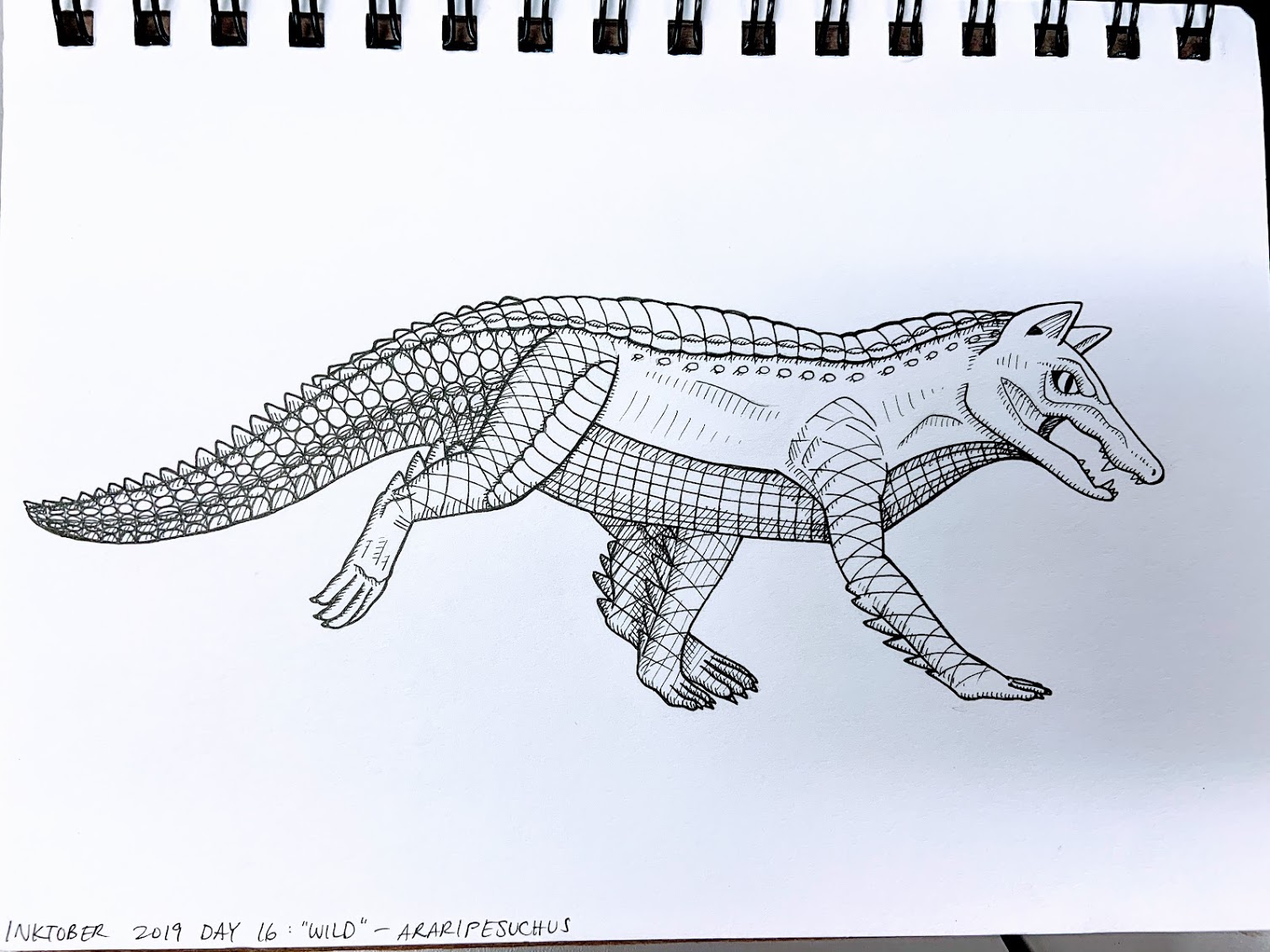
Day 16: Wild - Araripesuchus. Drawn in about an hour.
Araripesuchus was a notosuchian crocodylian from Cretaceous South America. Crocodylians are all semiaquatic ambush predators today, but in the past they were extremely diverse! There were sail-backed, beaked herbivorous crocs like Lotosaurus; theropod-mimic crocs like Effigia; ankylosaur-mimic crocs like Desmatosuchus; the aptly-named Armadillosuchus; the cat-like Pakasuchus; the fully-aquatic Dakosaurus; the hoofed croc Boverisuchus; and Postosuchus, which looked like a quadrupedal Tyrannosaurus, to name just a few. Crocodylians looked poised to take over the world in the Triassic period, but ended up taking a backseat when the dinosaurs rose to prominence.
Araripesuchus was part of a group of terrestrial crocs called notosuchians, many of which had certain features that were very convergent with mammals. These included heterodont dentition, or different types of teeth specialized for different purposes (molars versus incisors versus canines), and possibly external moveable ear-flaps, called pinnae. Modern crocs’ ear-lids, which they use to prevent water from getting in their ears, may even have evolved from these mammal-like external ear structures!
I picked Araripesuchus to be my “wild” both in the wild-animal sense that it gives off a kind of crazy fierceness, and in the “that’s wild” sense that it’s such a strange creature. Here, I’ve depicted Araripesuchus as being very convergent with a wolf. It came out a little unexpectedly Egyptian-looking (Anubis and Sobek had a baby?), but overall I’m happy with the composition. It’s very speculative–Araripesuchus is pretty basal on the notosuchian family tree, and even if it did have pinnae, they may not have been this prominent–but I think the world needs more creative paleoart of weird pseudosuchians, since they’re such a cool group that’s relatively unknown to the public. So here you go.
Notosuchian Ears Pose Reference
Halfway there!
I’d like to say a couple things now that we’re halfway through Inktober and I’ve gotten into the swing of things. First, you can find me over on Reddit at r/Paleoart and r/Dinosaurs, making these same posts and also responding to other Redditors’ comments and feedback. It’s been really cool seeing what people like and what they notice, and how my opinion of a piece and the amount of effort I put into it correlates (or doesn’t correlate) with number of upvotes. Redditors in general have been very supportive. The most-upvoted post so far was “Legend” (Tyrannosaurus), closely followed by “Build” (Protoceratops) and “Mindless” (Ctenochasma). I think people liked “Legend” because it was a famous subject and the infographic format was educational; I think people liked “Build” because it’s so cute and wholesome, even though it was relatively low-effort; and I think they liked “Mindless” because the black and white composition is striking. But the ones I put the most work into were “Mindless” and “Husky” (Olorotitan), which got hardly any upvotes. I think also the day of the week and time of day of posting matters, but it’s hard to tell from this dataset. Oh, and I can’t forget to mention the one other paleo Inktober Redditor I’ve befriended through this, u/jupiter1390. He/she has been super encouraging and awesome, and his/her skeletal art is really cool.
It’s been a couple years since I started getting super into dinosaurs and paleontology, but until now I haven’t really tried my hand seriously at paleoart, even though I’ve done other art (including animals, creature design, and video game fanart) for a long time. I think this is because the barrier to entry to paleoart is pretty dang high, and only now, after researching and reading about dinosaurs sort of nonstop for two years, do I have enough background knowledge to make any meaningful contribution to paleoart. When you draw a picture, you have to make assumptions about basically everything, since unlike text you can’t avoid mentioning a certain body part or feature or something, other than intentionally cropping it out. Without detailed knowledge of a lot of different groups of prehistoric creatures, the assumptions I made when I attempted paleoart in the past were bad. I could have done more research, but sometimes when you make assumptions, you don’t even realize you’re making them. I’m really glad that I’m at a point now where I can bring ideas to the table–like giving Araripesuchus ears, or showing Ctenochasma in the act of fishing, or making Leaellynasaura the fluffiest thing ever–that haven’t really been done before, but are still founded in actual science. It feels like I’m helping, in a tiny way, to advance the field.
Two resources that I found really helpful in making better paleoart are The Paleoartist’s Handbook by Mark Witton (and his blog, which is sort of an extension of that book), and All Yesterdays, by John Conway, Darren Naish, and CM Kosemen. Both of those describe how we know what we know, how to avoid paleoart “memes” / just copying what other paleoartists are doing, give examples of well-executed parsimonious as well as speculative paleoart, and are just super beautiful to look at.
I think the next hurdle in my paleoart career, now that I’ve become much more familiar with the paleo part, is, y’know, the art part. That definitely just takes practice and straight-up hours spent drawing. Hopefully if I continue doing things like this I’ll get better. I’ve learned that a lot of things in life are cumulative.
Thanks for sticking with me through my first half of my first Inktober. We’re over the hump and it’ll be easier from here on out. Right? Right??
Day 17: Ornament
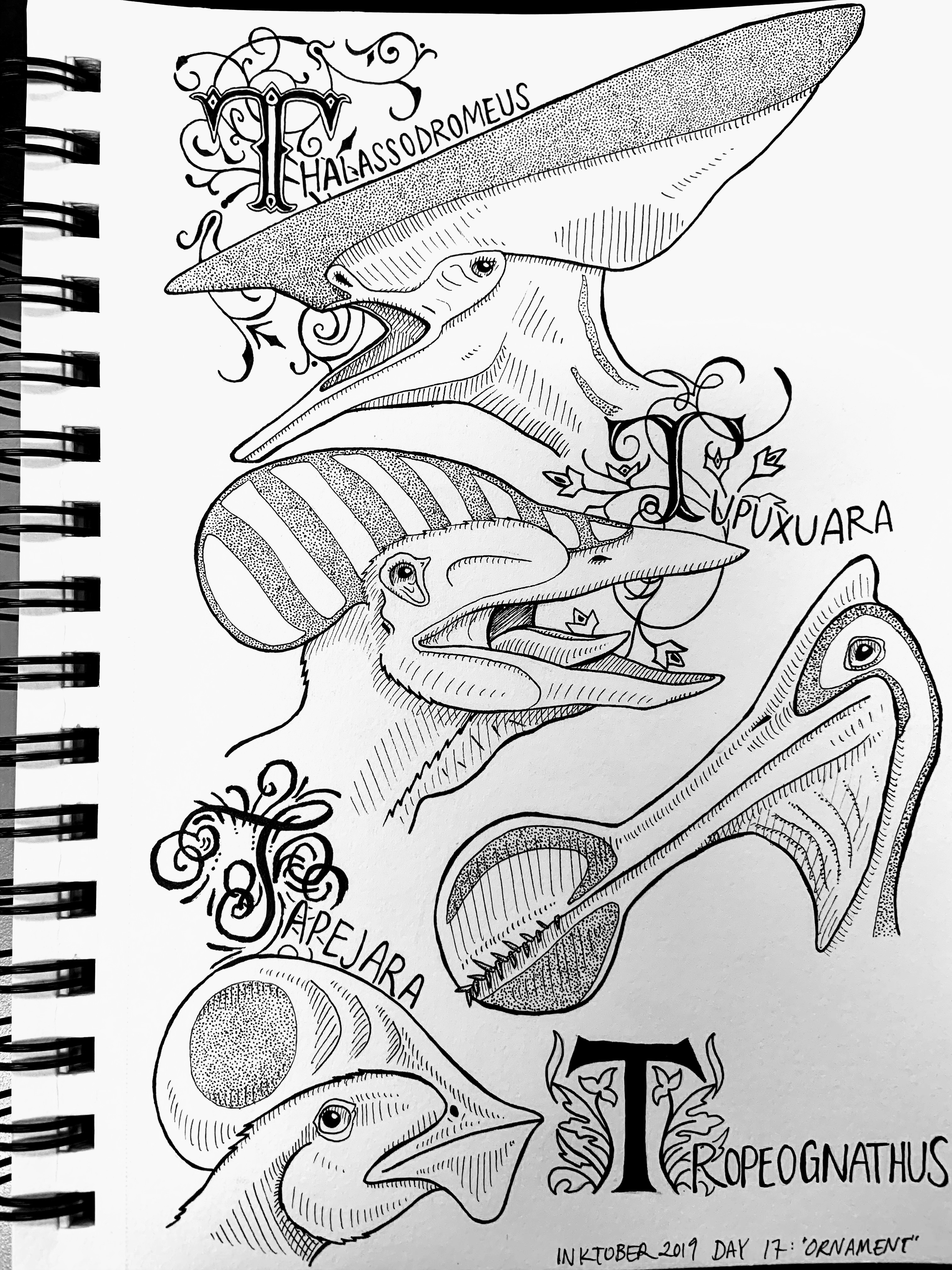
Day 17: Ornament - Fabulous Fliers of the Romualdo Formation. Drawn in about 3 hours. I sort of bit off more than I wanted to chew with respect to the area that needed to be stippled.
Thalassodromeus, Tupuxuara, Tropeognathus, and Tapejara were four pterodactyloid pterosaurs from Early Cretaceous Brazil. Tropeognathus is part of the Ornithocheiridae, which were some of the last pterosaurs to have teeth, and is on the same branch of the pterosaur family tree as Pteranodon. The other three were azhdarchoids; Thalassodromeus and Tupuxuara were closely related neoazhdarchids in the group Thalassodrominae, while Tapejara was in its own group named after it, the Tapejaromorpha (and Tapejaridae, Tapejarinae, and Tapejarini, in order of increasing closeness to Tapejara itself).
All these fabulous-crested pterosaurs were found in the Romualdo Formation, but it’s difficult to tell if they actually coexisted, since the formation spans about 3 million years. Originally I was just going to do Thalassodromeus for this prompt because its crest is one of the most extreme, but in my research I learned about its similarly-ornamented alliterative contemporaries and wanted to draw them all. Also…calligraphy?
Day 18: Misfit
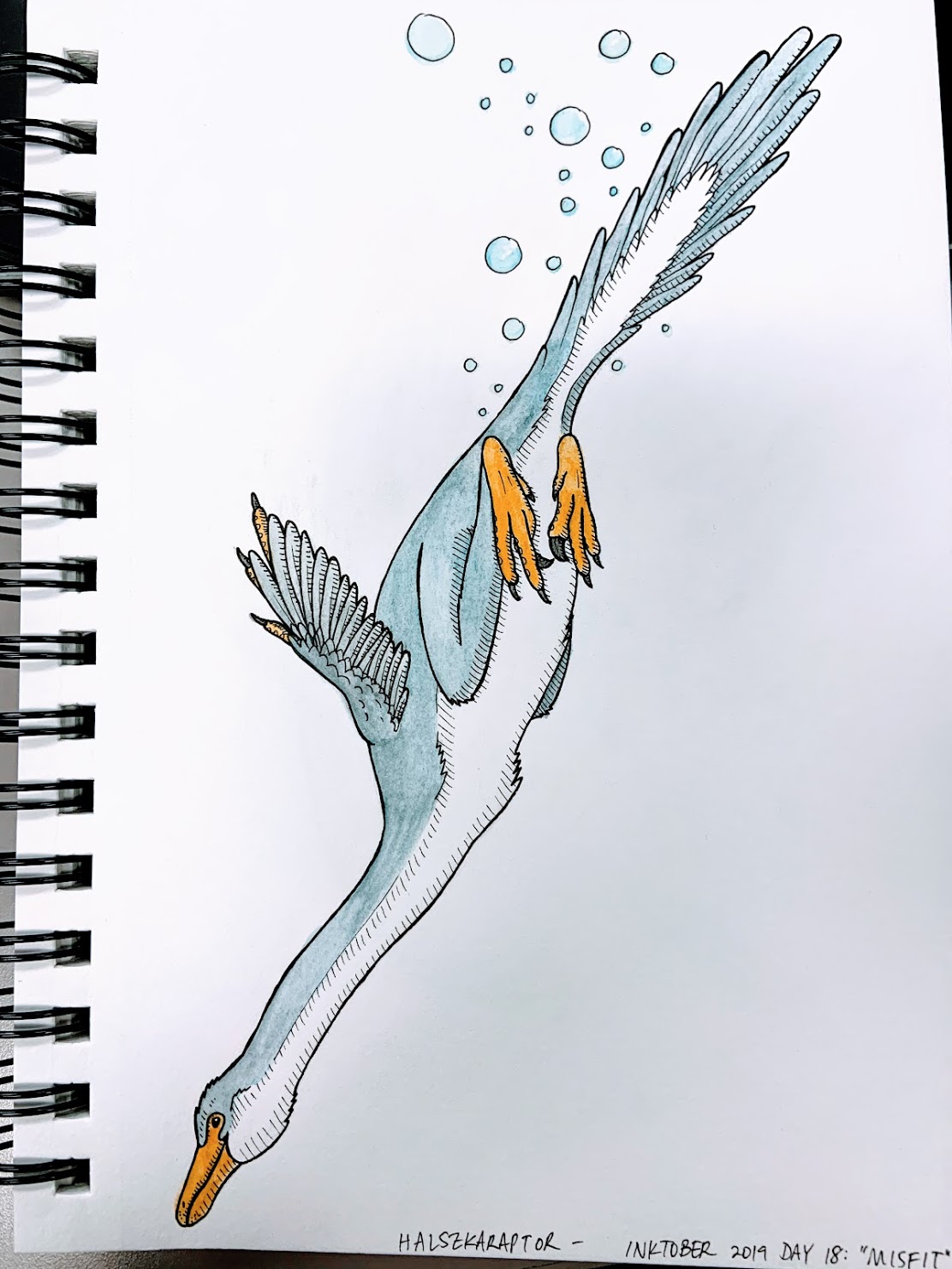
Day 18: Misfit - Halszkaraptor. Drawn in about 50 minutes.
It’s a bird! It’s a plane! No, it’s Halszkaraptor! (That is to say, yes, it’s indeed not a bird.) Halszkaraptor was a small dromaeosaur from Late Cretaceous Mongolia that was described just a couple years ago in 2017 and is notable for being one of the very few semiaquatic non-avian dinosaurs (the others are spinosaurids, Lurdusaurus, and Liaoningosaurus). We know this because its bone structure and density are similar to that of existing aquatic birds and crocodylians. Its teeth show that it ate fish, and it probably propelled itself through the water using its wings like a penguin. There’s also evidence for croc-like or spinosaurid-like sensory neurons in its snout to detect vibrations in the water to better hunt fish.
This prompt was a really good one for me because there are so many Mesozoic reptiles that could be considered misfits in various ways: creatures that fill ecological niches that nothing fills today, or ones that are “out of time,” doing something earlier or later than a majority of other animals, or black sheep that don’t fit the mold of the rest of their family. The other candidates I considered were Deinocheirus, the camel-duck-panda ornithomimosaur; Siats, an allosauroid that out-lived most of its brethren by tens of millions of years; and Lotosaurus, a toothless-beaked Triassic pseudosuchian that didn’t get the memo that wearing a sail on one’s back was in bad taste after the Great Dying.
Since the discovery of Halszkaraptor, I’m happily reminded of it whenever I see a cormorant. It’s cool to see a modern animal filling its ancestral cousin’s shoes.
Day 19: Sling
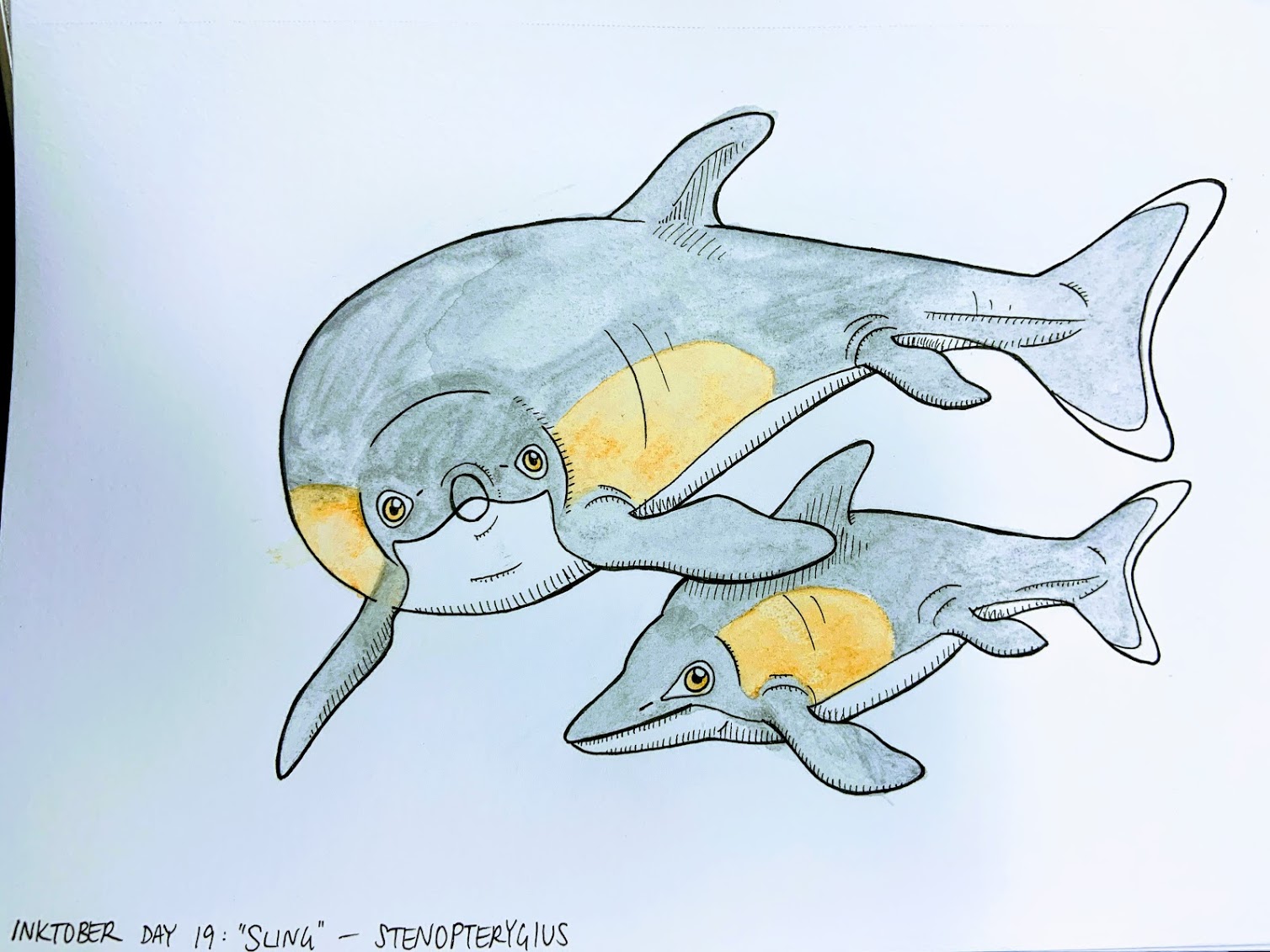
Day 19: Sling - Stenopterygius. Drawn in about 40 minutes.
Stenopterygius (meaning “narrow wing”) was an ichthyosaur from Early Jurassic Europe known from over 100 specimens, some of which preserve skin, blubber, bits of internal organs, and fetuses. We know a ton about this animal’s lifestyle–it was warm-blooded (since blubber isn’t useful otherwise), ate fish, was countershaded (light belly, dark back), and gave live birth tail-first similarly to cetaceans (to prevent the baby from drowning before it’s free of the mother).
Since they’re so convergent with dolphins, and dolphins exhibit “infant-carrying behavior” in which the baby is pulled along in the mother’s wake, I thought drawing an ichthyosaur mother “slinging” her baby along would be fitting. To be honest, this was probably the hardest prompt to relate to Mesozoic reptiles, so it’s a bit of a stretch. I gave them yellow patches like a common dolphin because that splash of color is hawt af.
New Stenopterygius Fossil With Blubber
Day 20: Tread

Day 20: Tread - Vouivria and Plesiochelys. Drawn in about an hour.
One day in Late Jurassic Switzerland, an unfortunate turtle was trodden upon by a sauropod. Just last month, the fossil preserving this tragic accident was found–a smashed Plesiochelys carapace within a sauropod footprint. We don’t know what sauropod was the culprit, so I picked Vouivria since it’s pretty new (described 2017) and roughly matches the time, place, and size of the incident. Vouivria was a basal brachiosaur that weighed about 15 tonnes–small-to-medium for a sauropod (an elephant is around 7 tonnes; the largest titanosaurs got up to 76 tonnes!).
Why does it appear to have a beak? Well, in 2017 a fossil skull of its close-ish cousin, Camarasaurus, was found with soft tissue preserved, showing that it had extensive mouth-gear, possibly including a keratinous beak. And at SVP 2019 on October 10, research was presented that examined more sauropod fossils and corroborated the theory further (good thing I put off doing an Inktober sauropod until Day 20!). This doesn’t strike me as too far-fetched, given how many times beaks have arisen independently among amniotes (I can think of at least 12 off the top of my head, which I’m sure isn’t a comprehensive list). Beaks are a very homoplastic trait. Personally, I think Vouivria looks pretty good in a beak.
Looking back at it now, I’m pretty sure Vouivria’s neck couldn’t actually bend the way it does in the last panel…whoops…
Footprint Find Camarasaurus Beak
Day 21: Treasure
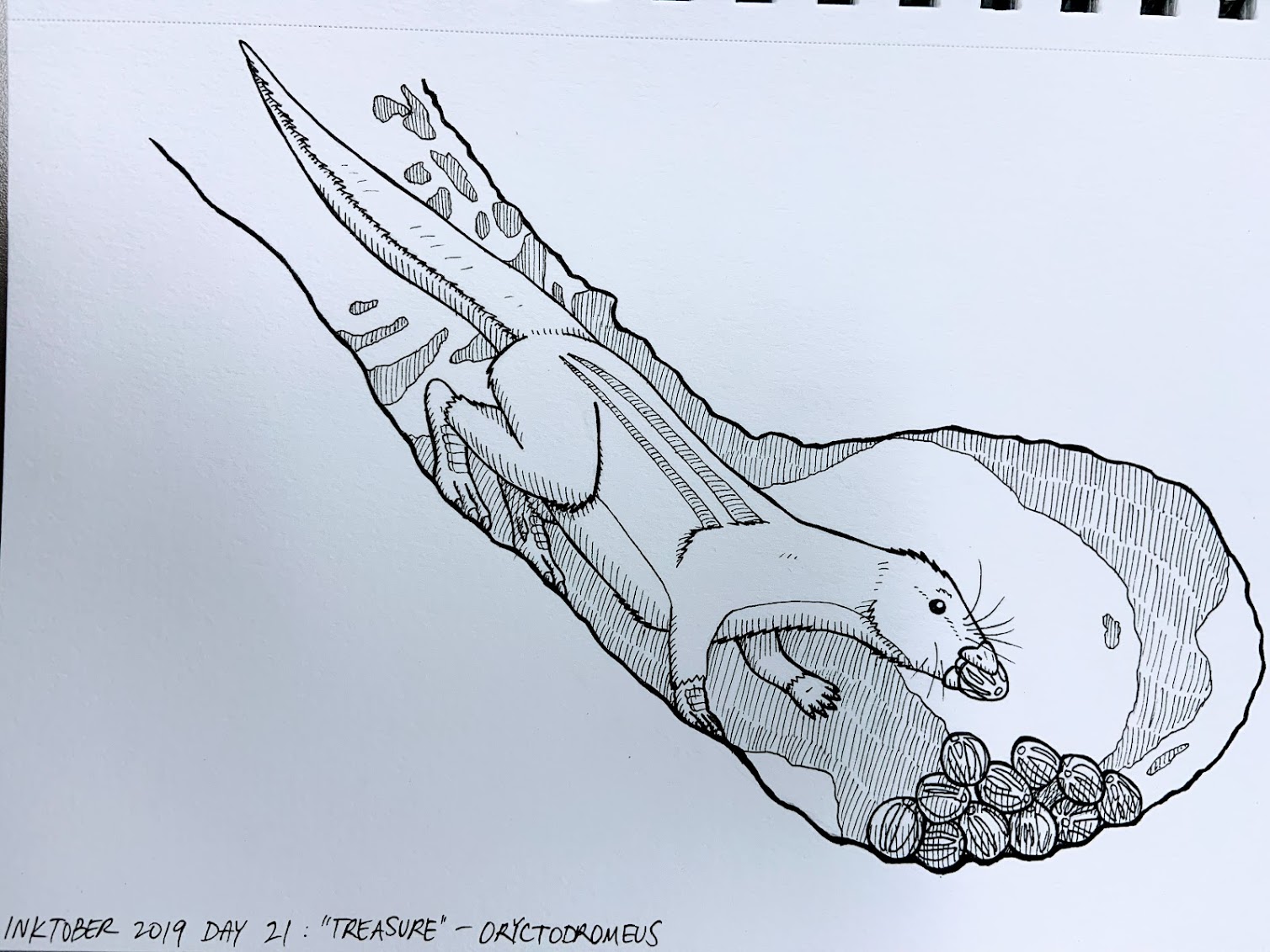
Day 21: Treasure - Oryctodromeus. Drawn in about an hour.
Oryctodromeus (meaning “digging runner”) was a smallish parksosaurid ornithischian from early Late Cretaceous Montana. Its fossils have been found in burrows, and it was the first known dinosaur to show direct evidence of fossorial behavior. Here, an Oryctodromeus is hoarding nuts and doing its best impression of a rat (well, if rats weighed 50 to 70 pounds). I gave it kiwi-bird-like whiskers to complete the image (kiwi birds are another example of dinosaurs convergent with rats. I’d say Oryctodromeus is more convincing though).
Day 22: Ghost
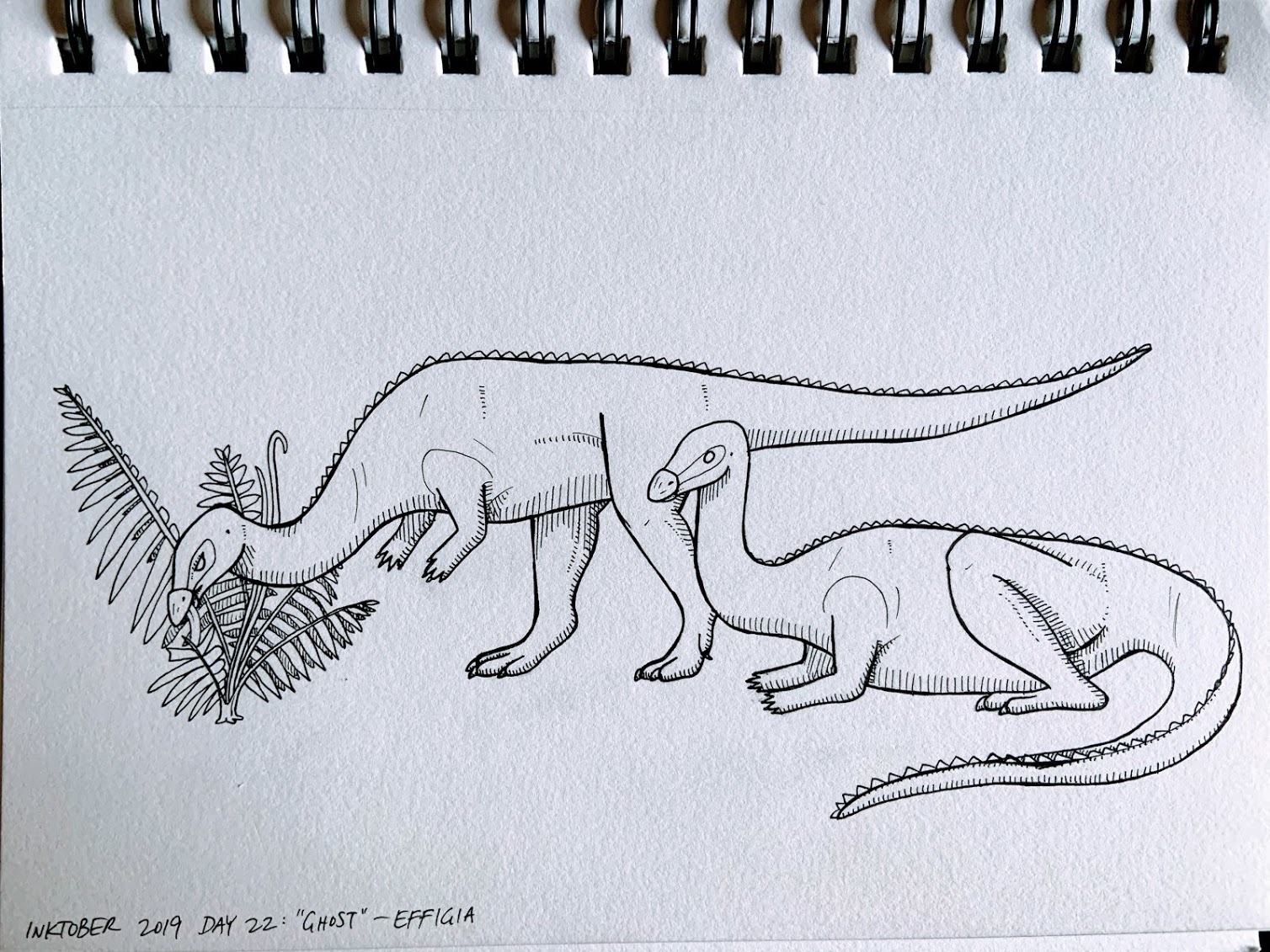
Day 22: Ghost - Effigia. Drawn in about an hour. Previously in my Inktober series, we saw a crocodilian pretending to be a wolf (Day 16); now, we have one pretending to be a dinosaur. That crurotarsal ankle looks weirdly humanlike…
Effigia was a very strange crocodilian from Latest Triassic New Mexico. It was found by Edwin Colbert in 1947 in a Coelophysis (a common small carnivorous dinosaur) bone bed at Ghost Ranch, and due to its extreme convergence with theropod dinosaurs, he thought Effigia was just another Coelophysis, packed it up in plaster, and forgot about it. It wasn’t until 2006 that someone opened the jacket and noticed that it was a beaked, herbivorous crocodilian. You can easily tell a crocodilian skeleton from a dinosaur skeleton based on the ankle–crocodilians (and, convergently, mammals) have crurotarsal ankles that hinge over two points and have a large heel for the calf muscle to attach to. Dinosaurs (including birds) have mesotarsal ankles, which hinge over one point and have no heel.
“Effigia” means “ghost” in Latin, referring both to its discovery at Ghost Ranch and its elusiveness, hiding amongst the Coelophysis.
Day 23: Ancient
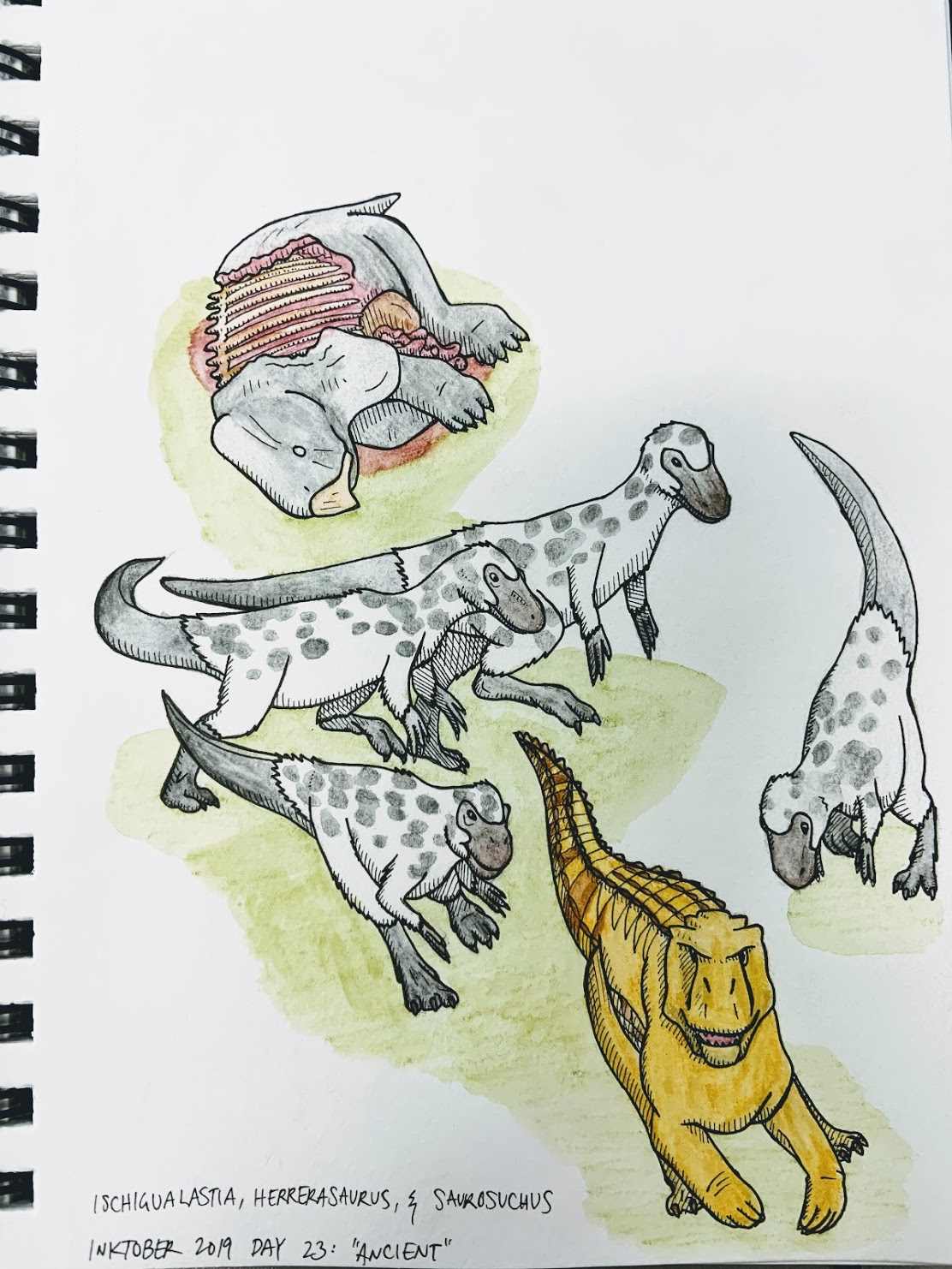
Day 23: Ancient - Megafauna of the Ischigualasto Formation. Drawn in about 3 hours. This didn’t turn out how I imagined it at all….definitely not my best work. But we persevere!
In early Late Triassic Argentina, the age of dinosaurs was just beginning. The previously dry Early and Middle Triassic climate gave way to monsoons and global warming in the Carnian Pluvial Event, which caused various extinctions and subsequent radiations of the survivors, including dinosaurs. Herrerasaurus was one of the earliest undisputed true dinosaurs, and man is it classic. Three fingers, three weight-bearing toes, medium-large, bitey, it sort of set a gold standard by which to compare other dinosaurs.
Herrerasaurus shared its environment with the large terrestrial crocodilian Saurosuchus, and the giant beaked dicynodont (stem-mammal) Ischigualastia. Altogether, the fauna of this period looked pretty alien compared to what we’re used to today. These creatures are really, really ancient–this was 231 million years ago. For scale, Tyrannosaurus lived 66 million years ago; Herrerasaurus is 3 times more ancient to Tyrannosaurus than Tyrannosaurus is to now!
Here, a pack of Herrerasaurus chase a Saurosuchus away from an Ischigualastia carcass. Are they defending their own kill, or stealing Saurosuchus’s? One on one, Herrerasaurus would’ve been no match for Saurosuchus, but a mob of them is something Saurosuchus doesn’t want to risk getting involved with. I’ve given Herrerasaurus some protofeathers because we now think it was the archosaurian ancestral condition, but not a lot of art currently reflects that. (You know what else is rare in paleoart right now? Dinosaurs and pseudosuchians from angles other than side view.)
Day 24: Dizzy

Day 24: Dizzy - Prenocephale. Drawn in about 2 hours.
Prenocephale was a pachycephalosaurid (dome-headed dinosaur) from Late Cretaceous Mongolia. This was one of the last groups of dinosaurs to arise, and they were closely related to the ceratopsians (horned-faced dinosaurs). They were small for dinosaurs, but Prenocephale adults still weighed around 300 pounds–the size of a bighorn sheep. Prenocephale had a rounder dome and less auxiliary horns than its North American relative, Pachycephalosaurus, indicating that it may have used the dome differently–one study suggested Pachycephalosaurus could’ve been a “shover” like a bison, while Prenocephale would’ve been a “rammer” like a bighorn. Pathologies (wounds) in the domes of adult specimens and not in juveniles show that the structures were probably used primarily for intraspecific sexual competition rather than defense or display.
Have you ever seen a video of two bighorns ramming each other? They rear up on their hind legs, charge forward, slam down, and then stand there for awhile. Maybe they’re dizzy from the impact. I’ve drawn my Prenocephale as being more muscular than it’s usually pictured, especially in the neck area–if they slammed downward like a bighorn, they’d need some heavy-duty neck muscles to resist the forces perpendicular to their spines. Here, a young upstart bull Prenocephale (left) challenges a mature alpha bull (right) to a headbutting match. I usually try not to fall back on paleoart memes and overdone poses, but this is such a dynamic one it was hard to pass up.
Stylistic Reference Anatomy Reference Headbutting Study
Day 25: Tasty
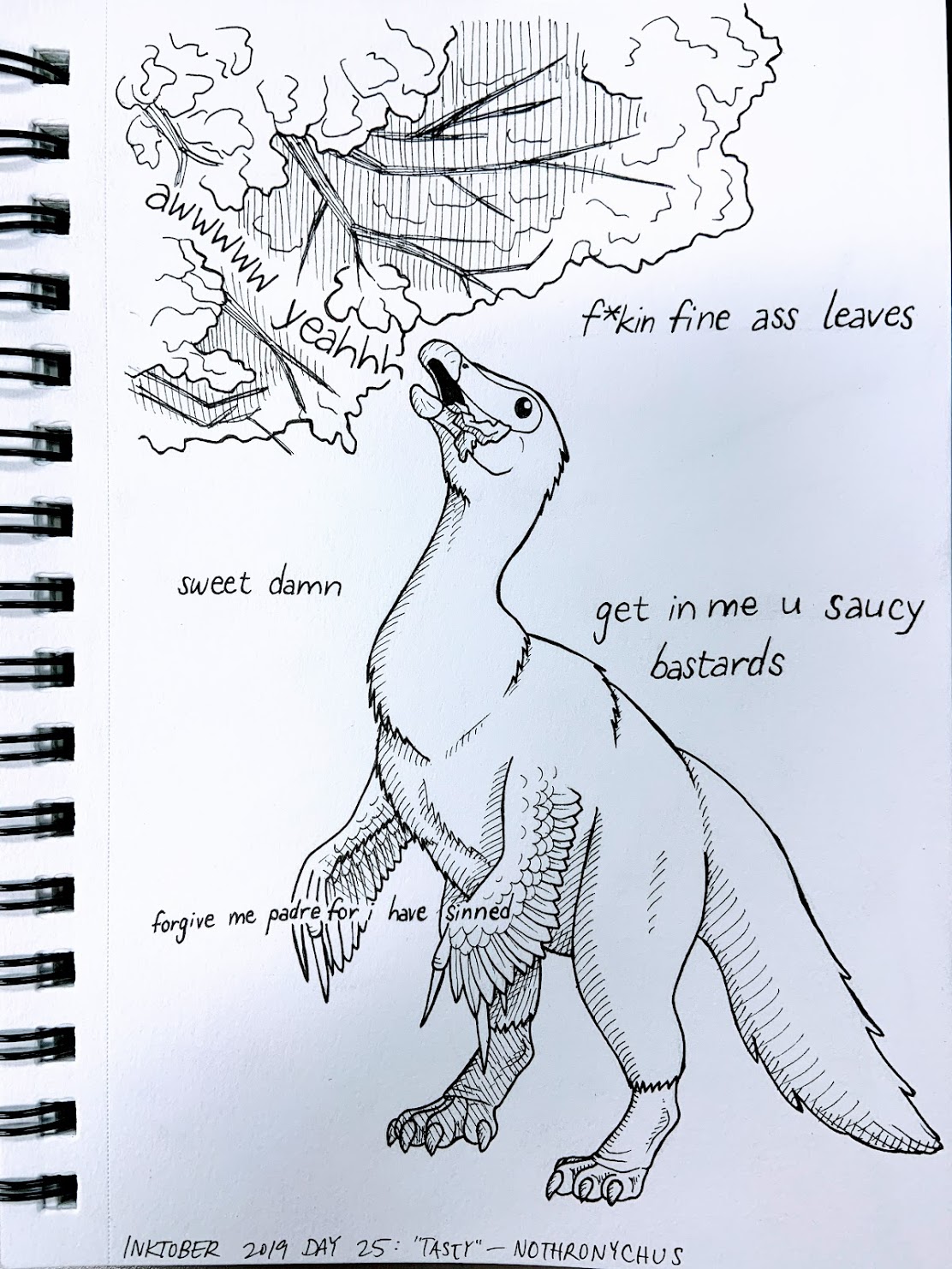
Day 25: Tasty - Nothronychus. Drawn in about 40 minutes.
Remember this meme? Here’s a recreation of it, but with a dinosaur!
Nothronychus (meaning “sloth claw”) was a therizinosaur from Late Cretaceous North America, one of the family of beaked, herbivorous maniraptorans with huge claws for stripping vegetation. They’re one of the many groups of saurischians that switched from carnivory to herbivory / omnivory, alongside the sauropods, ornithomimosaurs, oviraptorosaurs, and various birds. Why is going from carnivore to herbivore so common, while going the other way is so rare? I couldn’t actually find any answers to this. If you have any theories, let me know!
Day 26: Dark
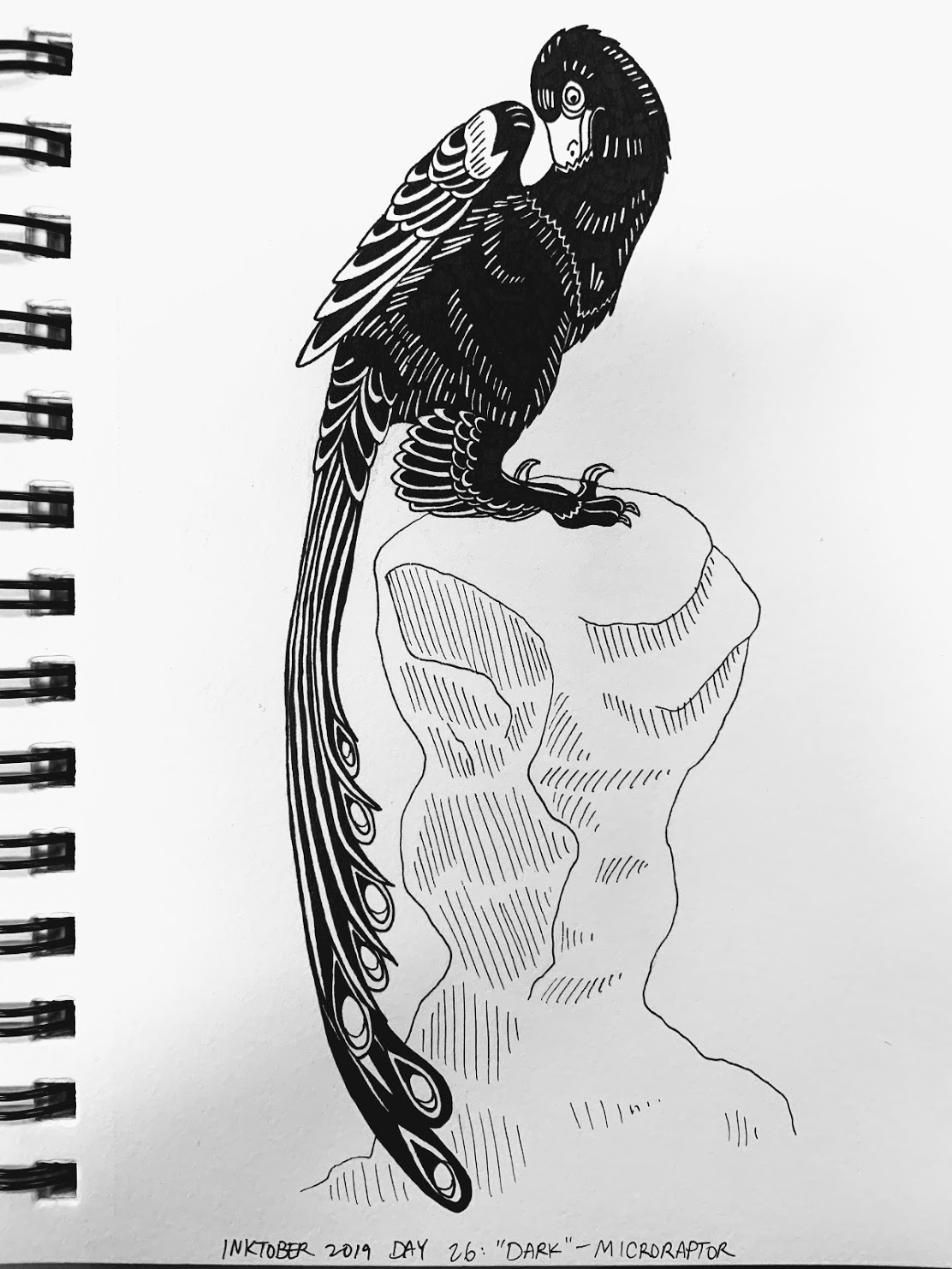
Day 26: Dark - Microraptor. Drawn in about 90 minutes.
Microraptor was a small, four-winged dromaeosaur from Early Cretaceous China known from over 300 specimens, some of which preserve lots of soft tissue, including feathers. Melanosome (color-determining organelle) studies on the feathers have shown that Microraptor was iridescent black like a crow or grackle, and was thus probably diurnal (since iridescence isn’t useful at night).
Did it fly, or just glide? (Probably flew.) Did it look like an X-wing or a kite while doing so? (Probably started a flight out like a kite, but transitioned to X-wing as it glided.) Did it live in trees? (Probably not.) Why do some specimens have two long tail feathers and others don’t? A lot of research is going into these questions (a lot of research can be done given the ridiculous number of specimens available) but we don’t have super-confident answers yet. As time goes on and more people attack the Microraptor specimens, we’ll probably learn a lot more about this animal’s lifestyle!
Here, an itchy Microraptor preens itself atop a hoodoo-like rock. I’m pretty sure there wasn’t any reason for hoodoos to be common in the Jehol ecosystem, but I wanted my Microraptor to show off its long tail without being in a tree.
Day 27: Coat
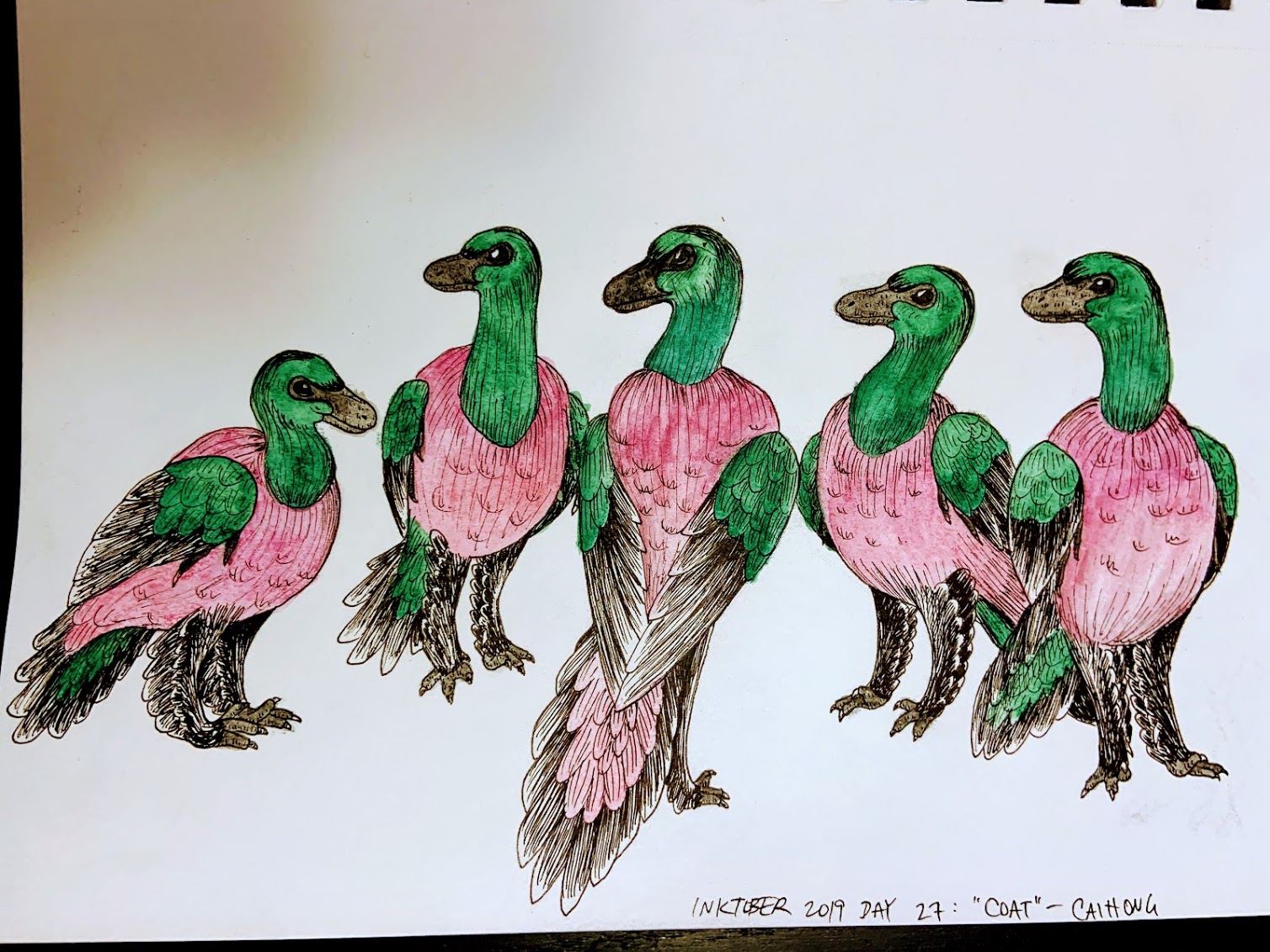
Day 27: Coat - Caihong.
“Smokin’ hot hen behind you…don’t all look at once!!”
Caihong (meaning “rainbow”) was a paravian dinosaur from Late Jurassic China. Through melanosome studies, it’s one of the few dinosaurs we know the color of in detail–its throat, top of wings, and base of tail were some iridescent color in the manner of trumpeter birds, while its main wing feathers, legs, and tail were black.
Similarly to trumpeters, my Caihong are a flock of ground-birds that just hang around shooting the breeze and making loud noises all day. Unfortunately, my Caihong are also super ugly. Oh well, they can’t all be winners….
Day 28: Ride
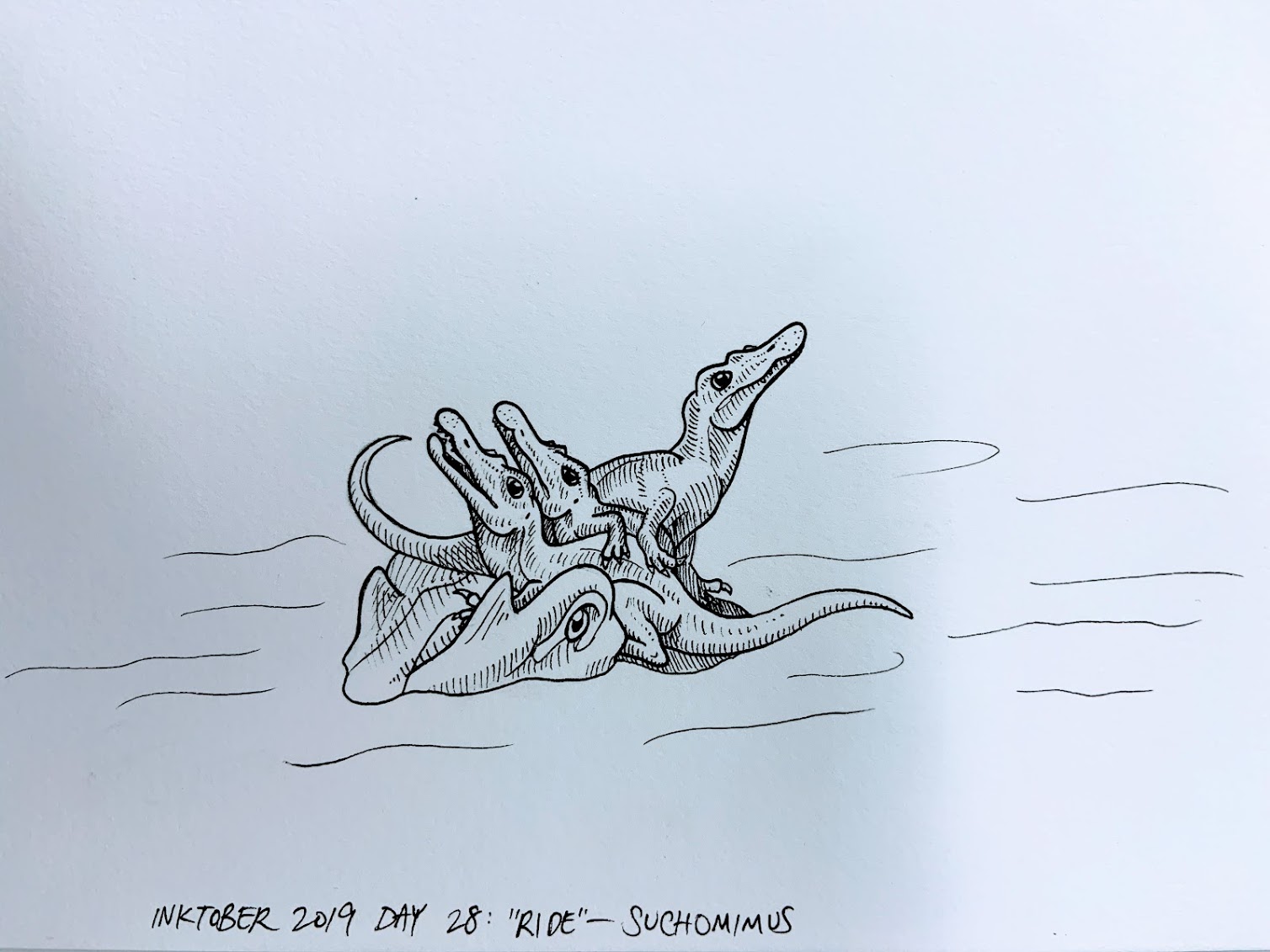
Day 28: Ride - Suchomimus. Drawn in about 30 minutes.
Suchomimus (meaning “crocodile mimic”) was a spinosaurid from Early Cretaceous North Africa. It was one of a family of fish-eating semi-aquatic apex predators, and one of the few non-avian dinosaurs adapted to a semi-aquatic lifestyle (the others are Lurdusaurus, Halszkaraptor, and Liaoningosaurus). Spinosaurids shared a number of features with modern semi-aquatic crocodiles, such as the elongated snout ending in a rosette, the conical fish-grabbing teeth, and the possible pressure-sensitive holes in the tip of the snout. If they had all that in common, it’s not a bad guess that they shared behaviors as well. Here, a Suchomimus mother gives three hatchlings a ride on her head. That middle one looks a bit uncomfortable, no?
Day 29: Injured
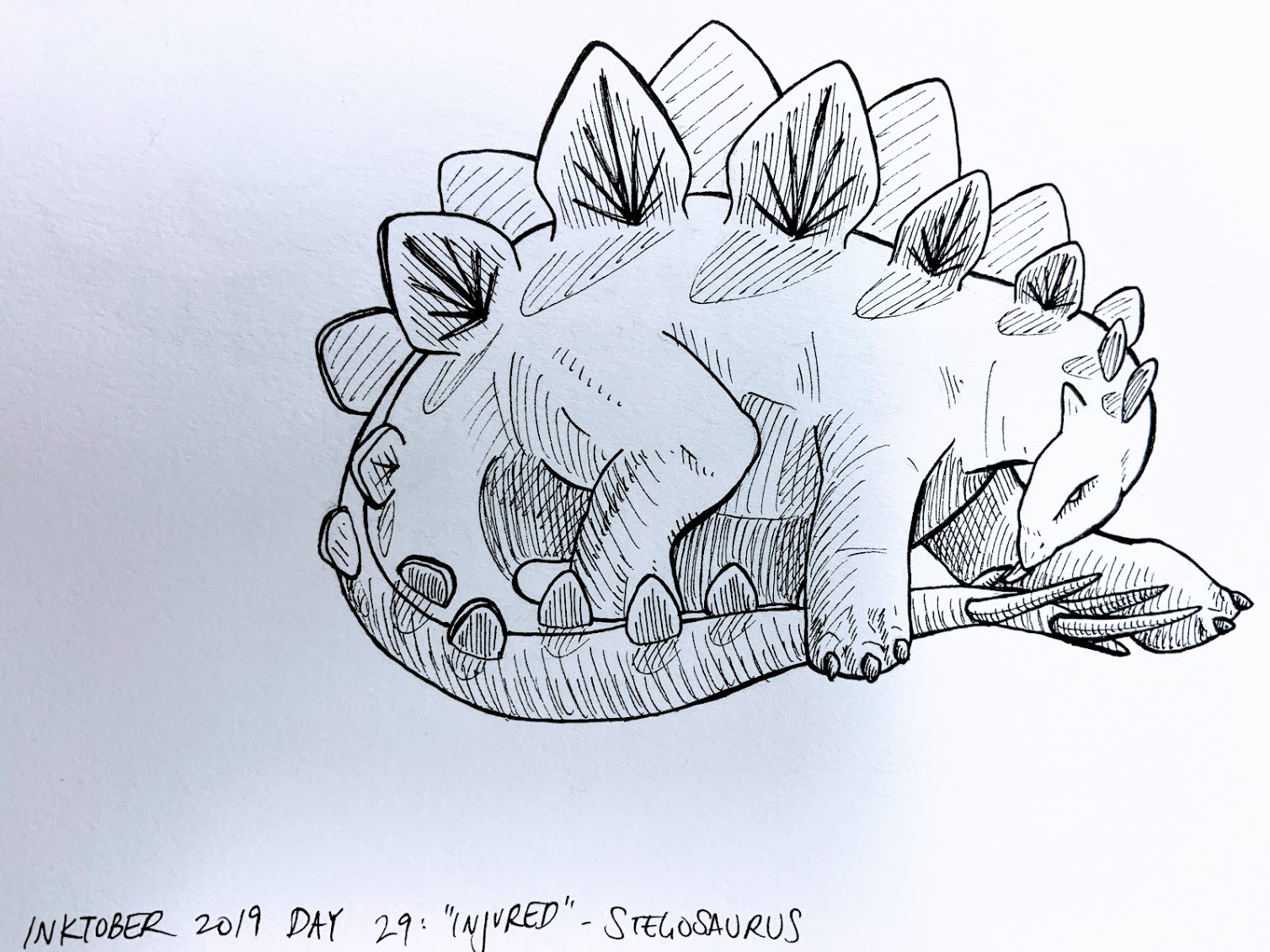
Day 29: Injured - Stegosaurus. Drawn in about an hour.
In Late Jurassic Colorado, a Stegosaurus stenops sits down to nurse its injured thagomizer spike. The spike broke off several months ago, and since then infection has set in, causing internal bone loss and a “melted candle wax” appearance. Unbeknownst to this Stegosaurus, drought and forest fires will strike the area shortly, leaving so many animals dead that the scavengers won’t be able to keep up. This weakened Stegosaurus will be one of the drought’s victims, and its carcass will later be buried mostly untouched by a flash flood when the drought breaks. Then, hundreds of millions of years later, it will be dug up by curious primates, be given the label DMNH 2818, and have its story pieced back together.
Art Reference Description of Fossil
Day 30: Catch
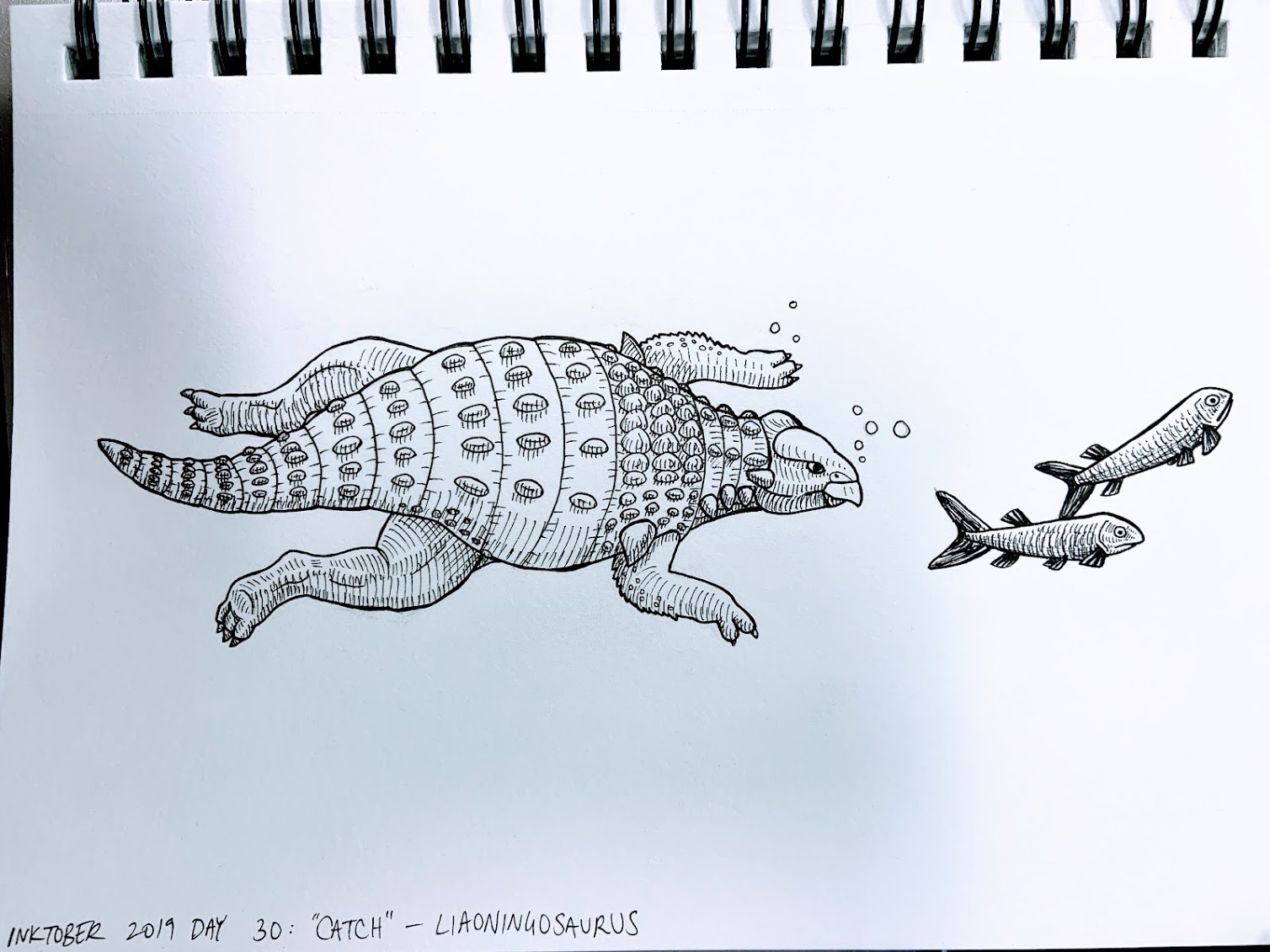
Day 30: Catch - Liaoningosaurus. Drawn in about 90 minutes.
Another semiaquatic non-avian dinosaur today, the tiny ankylosaur Liaoningosaurus, from the Jehol Biota of Early Cretaceous China. This little guy was only a bit over a foot long, and fossils of it were found with fish remains preserved in the gut. It also has a pelvis that isn’t fused to the spine, numerous large fork-like teeth in its beak, and long sharp claws, all of which are possible adaptations to a semiaquatic lifestyle.
Here, a Liaoningosaurus chases two Lycoptera, a type of fish that was very common in the Jehol Biota. This is probably the aftermath of a failed ambush, and the dinosaur is now futilely swimming after the much faster fish. It really looks like such a creature would never be able to nab a fish, but hey, snapping turtles do it somehow, and the fossil record doesn’t lie.
Day 31: Ripe
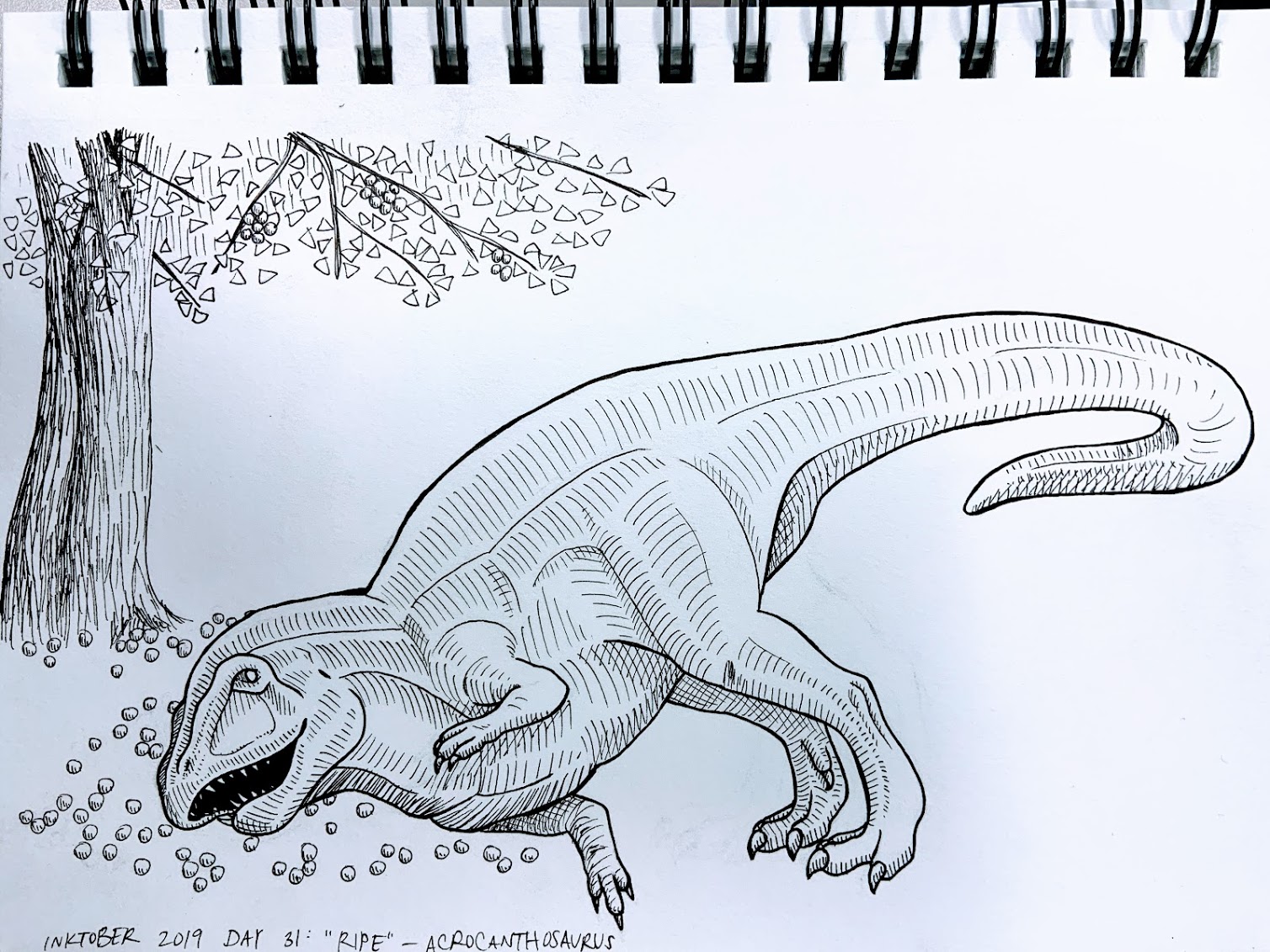
Day 31: Ripe - Acrocanthosaurus, rolling in something. Drawn in about an hour.
Acrocanthosaurus (meaning “high spine lizard”) was a carcharodontosaur from Early Cretaceous North America. It was one of the “shark-toothed dinosaurs,” and was the apex predator of its ecosystem (it would be replaced by Tyrannosaurs a few tens of millions of years later). Acrocanthosaurus is notable for its tall neural spines that probably supported a chunky ridge of muscle and fat along its back, sort of like a bison.
Here, an Acrocanthosaurus rolls in a pile of stinky Ginkgo digitata false-fruit. You may be familiar with the stench of Ginkgo bilboa, the only living species of ginkgo tree, whose carrion-like musk attracts predators and scavengers to disperse the seeds. The ripe false-fruits (they’re not true fruits because ginkgos are gymnosperms, not angiosperms) tend to fall in big stinky piles, which looked and smelled like a lot of fun to this Acrocanthosaurus.
I picked Acrocanthosaurus because (a) I haven’t done any allosauroids yet for Inktober (and Acrocanthosaurus is indisputably the coolest allosauroid), and (b) I wanted to show a stereotypical bloodthirsty carnivore interacting peacefully with plants, because it’s a thing that presumably happened all the time but is rarely shown in paleoart.
